We Review Honda's Two New 6-Speed DCT Multi-Sport UTV’s
Aug. 27, 2019
[caption id="attachment_64219" align="alignnone" width="1000"]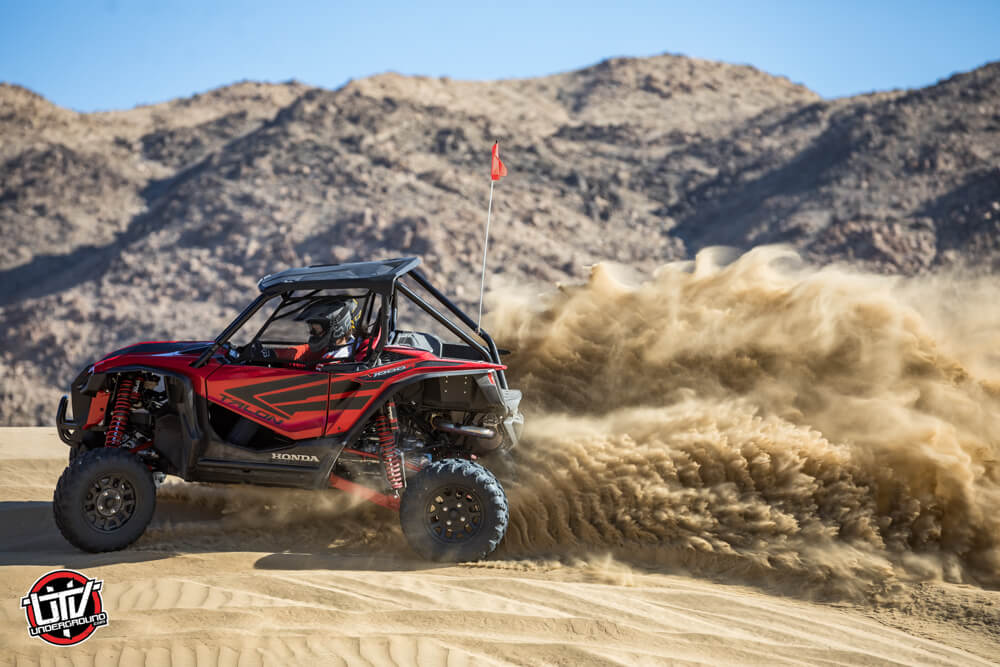 The Talon 14000R has a 4+ link trailing arm suspension setup and is about 5” wider all around with 2.5” Fox Podium QS3 shocks – perfect for the desert.[/caption]
Last year Honda’s Ohio engine plant celebrated the production of their twenty-five millionth engine, since opening the facility in 1985. Let that sink in for a second. That’s one plant, in the US - that has made 25 million motors. A few weeks ago, almost a year to the day, UTVUnderground was invited to the hallowed ground of the Honda Proving Center near Tehachapi California - to an exclusive advanced preview of not one, but two of the most anticipated new products from Honda in nearly a decade, the 2019 Honda Talon 1000R and 1000X. You may have seen the leaked photos. You may have heard the hype. Here is the definitive breakdown of the Honda Talon. This is one machine you will want to drive as soon as is humanly possible. It’s that good.
https://youtu.be/G8WBdOkzWAQ
The new Honda Talon UTV is two machines - both 999cc and roughly 104 horsepower. The Talon 1000R has a 4+ link trailing arm suspension setup and is about 5” wider all around with 2.5” Fox Podium QS3 shocks - perfect for the desert. The Talon 1000X has a traditional 3 link setup, 2” Fox Podium QS3 shocks and is more agile/nimble and suited to the trails. Both are identical in every way except for their size and suspension.
[caption id="attachment_64232" align="aligncenter" width="1000"]
The Talon 14000R has a 4+ link trailing arm suspension setup and is about 5” wider all around with 2.5” Fox Podium QS3 shocks – perfect for the desert.[/caption]
Last year Honda’s Ohio engine plant celebrated the production of their twenty-five millionth engine, since opening the facility in 1985. Let that sink in for a second. That’s one plant, in the US - that has made 25 million motors. A few weeks ago, almost a year to the day, UTVUnderground was invited to the hallowed ground of the Honda Proving Center near Tehachapi California - to an exclusive advanced preview of not one, but two of the most anticipated new products from Honda in nearly a decade, the 2019 Honda Talon 1000R and 1000X. You may have seen the leaked photos. You may have heard the hype. Here is the definitive breakdown of the Honda Talon. This is one machine you will want to drive as soon as is humanly possible. It’s that good.
https://youtu.be/G8WBdOkzWAQ
The new Honda Talon UTV is two machines - both 999cc and roughly 104 horsepower. The Talon 1000R has a 4+ link trailing arm suspension setup and is about 5” wider all around with 2.5” Fox Podium QS3 shocks - perfect for the desert. The Talon 1000X has a traditional 3 link setup, 2” Fox Podium QS3 shocks and is more agile/nimble and suited to the trails. Both are identical in every way except for their size and suspension.
[caption id="attachment_64232" align="aligncenter" width="1000"] Honda Talon 1000R[/caption]
The Talon is built around a (DCT) dual clutch drivetrain which means no belts or chains. It’s an automatic 6-speed engine that sounds and feels like a real car thanks to clever tuning. It features a remarkable paddle shift system on the steering column that allows the driver the ability to bang gears like a World Rally Car and its intelligent 4-wheel drive system is way more advanced than just a simple locking diff. The dash, seats, doors, and interior components are incredibly refined and feel sturdy and finished.
Honda Talon 1000R[/caption]
The Talon is built around a (DCT) dual clutch drivetrain which means no belts or chains. It’s an automatic 6-speed engine that sounds and feels like a real car thanks to clever tuning. It features a remarkable paddle shift system on the steering column that allows the driver the ability to bang gears like a World Rally Car and its intelligent 4-wheel drive system is way more advanced than just a simple locking diff. The dash, seats, doors, and interior components are incredibly refined and feel sturdy and finished.
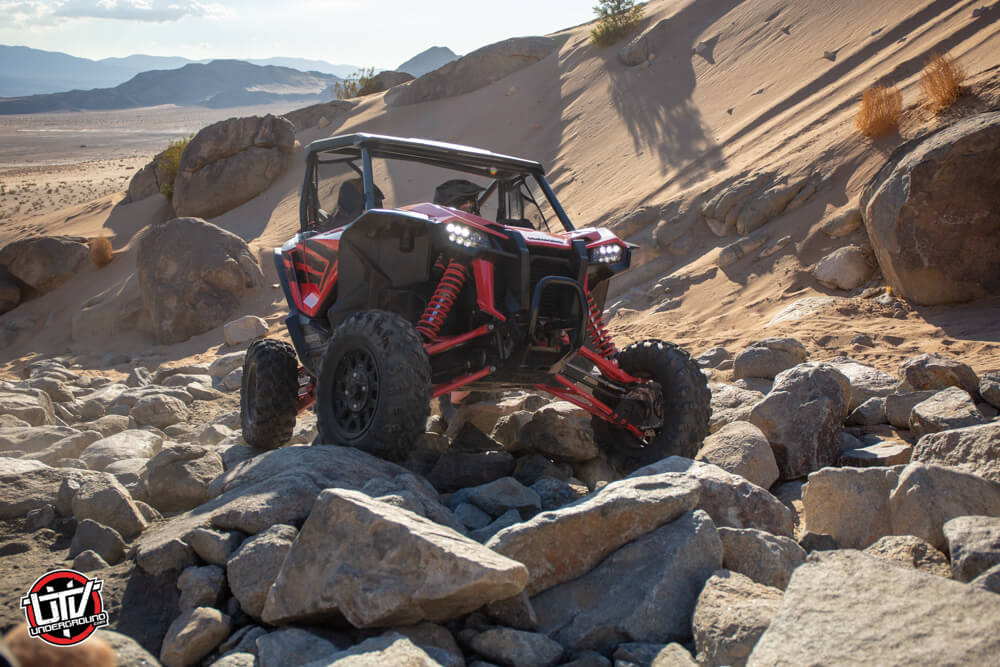 [gallery type="rectangular" link="file" ids="64258,64260,64261,64262,64263,64264"]
How does it drive? In a word - AWESOME. It feels fast, powerful, solid, predictable, and the steering response is fantastic. It soaks up whoops and rutts and has lots of top end going uphill in the thick rock and shale. This machine, is an all around fantastic UTV, and exactly what you would expect from Honda. WIll it compete head to head with the Polaris RZR Turbo S and Can AM Maverick X3 Turbo R? No. But it’s not supposed to. But it packs a wallop of a punch in it’s category. Honda is going after the “multisport” segment and these Talon’s are a solid entry into the market for them, especially considering the specs of the 2019 Honda Talon.
[gallery type="rectangular" link="file" ids="64258,64260,64261,64262,64263,64264"]
How does it drive? In a word - AWESOME. It feels fast, powerful, solid, predictable, and the steering response is fantastic. It soaks up whoops and rutts and has lots of top end going uphill in the thick rock and shale. This machine, is an all around fantastic UTV, and exactly what you would expect from Honda. WIll it compete head to head with the Polaris RZR Turbo S and Can AM Maverick X3 Turbo R? No. But it’s not supposed to. But it packs a wallop of a punch in it’s category. Honda is going after the “multisport” segment and these Talon’s are a solid entry into the market for them, especially considering the specs of the 2019 Honda Talon.
Click here for a model comparison. Click here for design interview. Click here for chassis interview. Click here for testing interview. Click here for production interview.
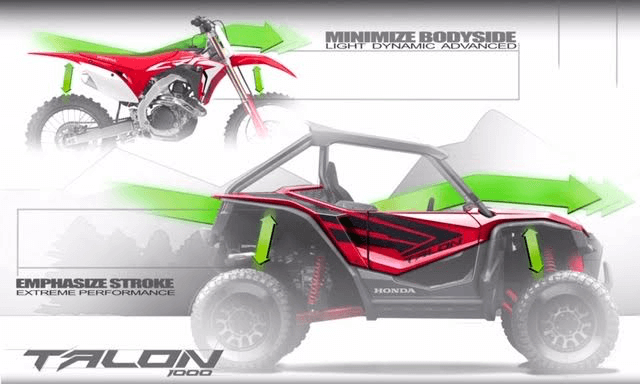 The Honda CR and CRF dirt bikes have been the gold standard for decades. And it’s from that world that these new machines were born. The Honda engineers and design team we met were basically given a blank canvas and told to build something that lived up to the Honda name. A machine that spoke to the tradition of the Honda dirt bike lineage, and they did just that. In fact it was early in the design process that the team of Jon Seidel, Joe Gilkerson, Wayne Lambert and Jeremy McGuire realized they couldn’t pack everything into one vehicle, and the 1000X and 1000R Talon’s were born.
The Honda CR and CRF dirt bikes have been the gold standard for decades. And it’s from that world that these new machines were born. The Honda engineers and design team we met were basically given a blank canvas and told to build something that lived up to the Honda name. A machine that spoke to the tradition of the Honda dirt bike lineage, and they did just that. In fact it was early in the design process that the team of Jon Seidel, Joe Gilkerson, Wayne Lambert and Jeremy McGuire realized they couldn’t pack everything into one vehicle, and the 1000X and 1000R Talon’s were born.
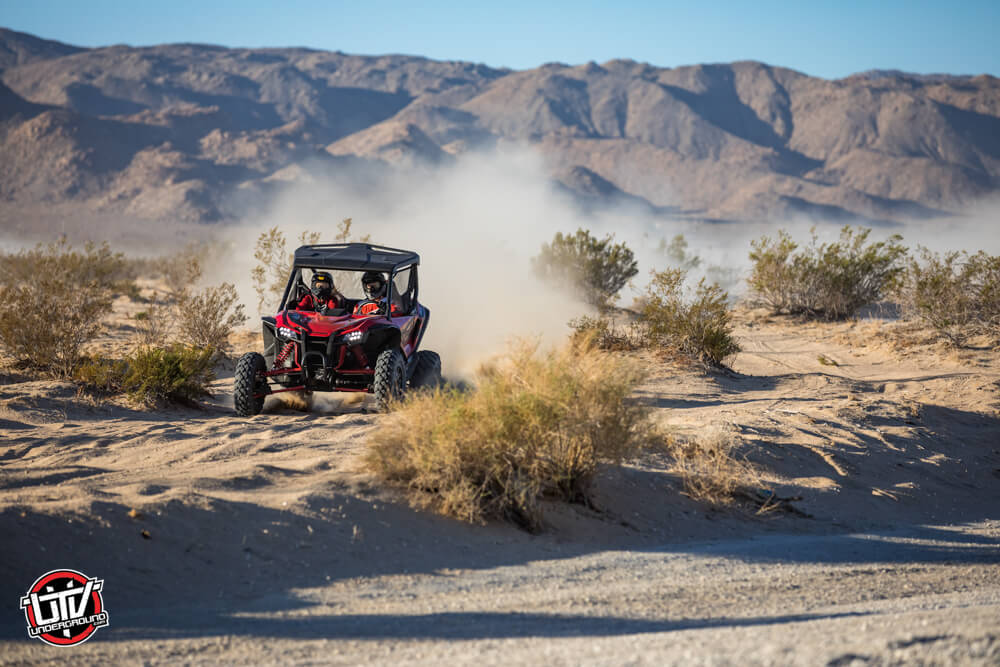 [gallery type="rectangular" link="file" ids="64265,64266,64267,64268,64269,64270"]
Design. The Talon was designed at Honda R&D in Torrance, California and the vehicle is dominated by a high bodyline and a body side that has a continuous flow from front to rear. When looking at the machine it has a pronounced, strong stance, which was created by placing the four wheels at the extreme corners of the vehicle. To us when you look at the aggressive fenders and wheel wells it screams out for 32” tire - or bigger! The roof, which comes standard on the Talon, incorporates a front lip to keep moisture from reaching the interior (even when braking in rainy conditions), and a horizontal pass-through slit both creates a functional spoiler (providing downforce at higher speeds) and allows appropriate aerodynamics when the vehicle is towed on a trailer, whether it’s facing forward or backward. Leave it to Honda to improve on something as simple as a roof.
[gallery type="rectangular" link="file" ids="64265,64266,64267,64268,64269,64270"]
Design. The Talon was designed at Honda R&D in Torrance, California and the vehicle is dominated by a high bodyline and a body side that has a continuous flow from front to rear. When looking at the machine it has a pronounced, strong stance, which was created by placing the four wheels at the extreme corners of the vehicle. To us when you look at the aggressive fenders and wheel wells it screams out for 32” tire - or bigger! The roof, which comes standard on the Talon, incorporates a front lip to keep moisture from reaching the interior (even when braking in rainy conditions), and a horizontal pass-through slit both creates a functional spoiler (providing downforce at higher speeds) and allows appropriate aerodynamics when the vehicle is towed on a trailer, whether it’s facing forward or backward. Leave it to Honda to improve on something as simple as a roof.
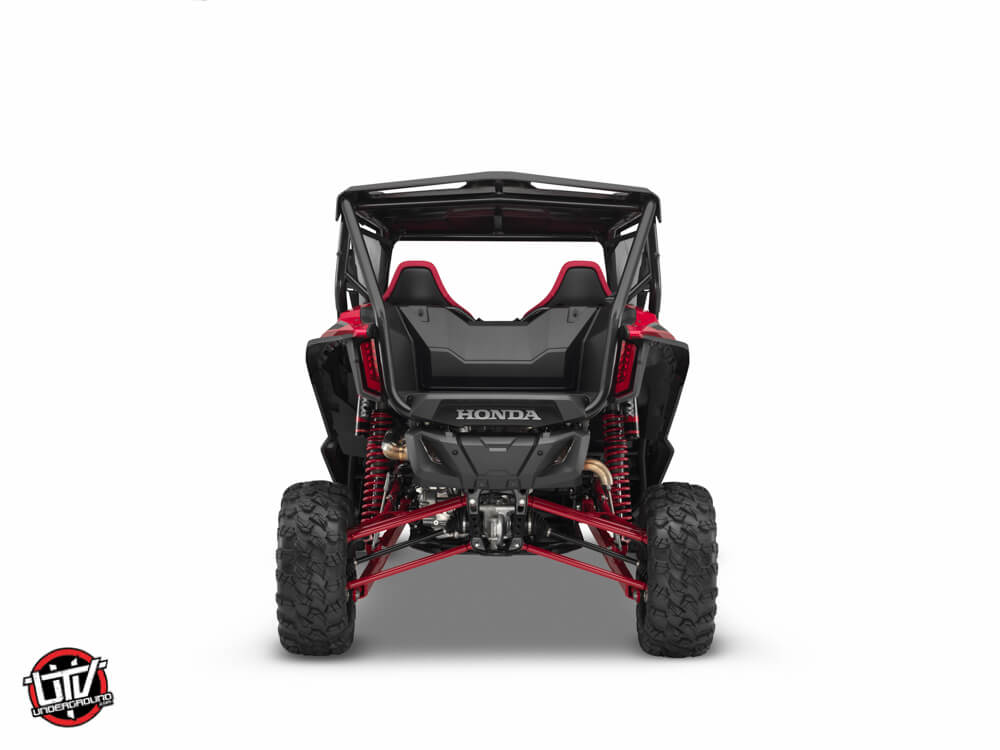 The open bed style rear end of the Talon might throw some of you off at first. There’s no flip down bed like the Polaris General, and no molded bed like the RZR. But the fact is neither are going to keep your gear from going flying. The Talon bed is large enough for a big cooler, and six integrated tie-down points allow items to be secured for aggressive driving. They offer a soft bag that drops right in - which makes a ton of sense. A flag mount is incorporated into the rollover protection system. Nice little touches that add up.
The open bed style rear end of the Talon might throw some of you off at first. There’s no flip down bed like the Polaris General, and no molded bed like the RZR. But the fact is neither are going to keep your gear from going flying. The Talon bed is large enough for a big cooler, and six integrated tie-down points allow items to be secured for aggressive driving. They offer a soft bag that drops right in - which makes a ton of sense. A flag mount is incorporated into the rollover protection system. Nice little touches that add up.
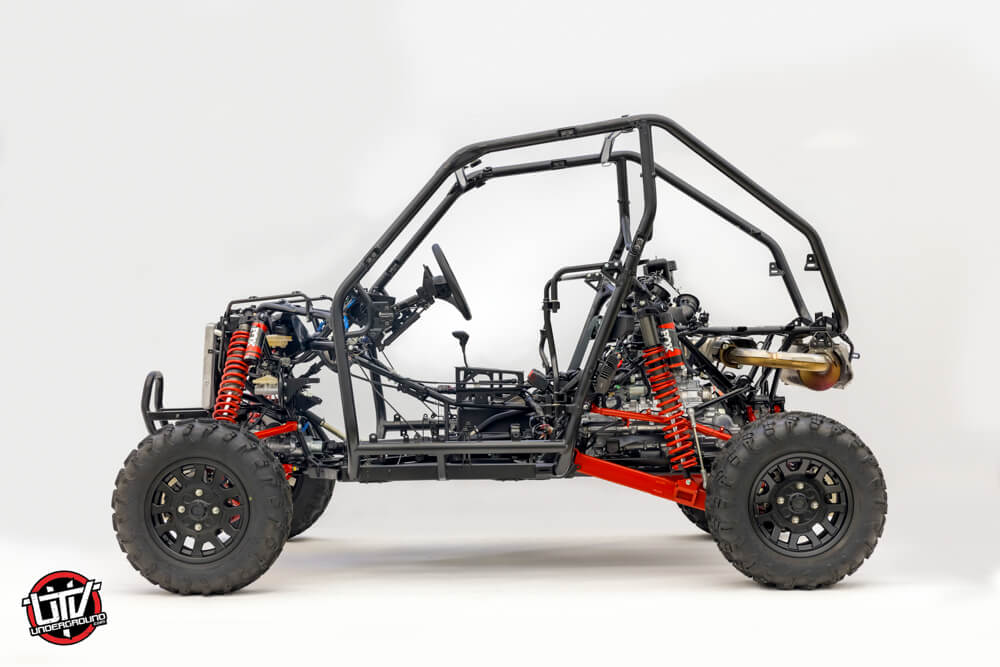 [gallery type="rectangular" ids="64286,64287,64288,64289,64290,64291,64292,64293,64294"]
Chassis. So the Talon looks cool and feels refined and well built on the inside, but what about the guts - as in, does it have any? Yes. The frame and suspension components were engineered and developed for a plush ride, maximum ground clearance and precise steering response. The frame itself is identical in both models, but the Talon 1000X’s suspension and wheelbase are intended to emphasize maneuverability and precise handling, (trail riding) while the Talon 1000R’s are tilted more toward high-speed tracking and large bump absorption; (desert racing and rock bouncing).
[gallery type="rectangular" ids="64286,64287,64288,64289,64290,64291,64292,64293,64294"]
Chassis. So the Talon looks cool and feels refined and well built on the inside, but what about the guts - as in, does it have any? Yes. The frame and suspension components were engineered and developed for a plush ride, maximum ground clearance and precise steering response. The frame itself is identical in both models, but the Talon 1000X’s suspension and wheelbase are intended to emphasize maneuverability and precise handling, (trail riding) while the Talon 1000R’s are tilted more toward high-speed tracking and large bump absorption; (desert racing and rock bouncing).
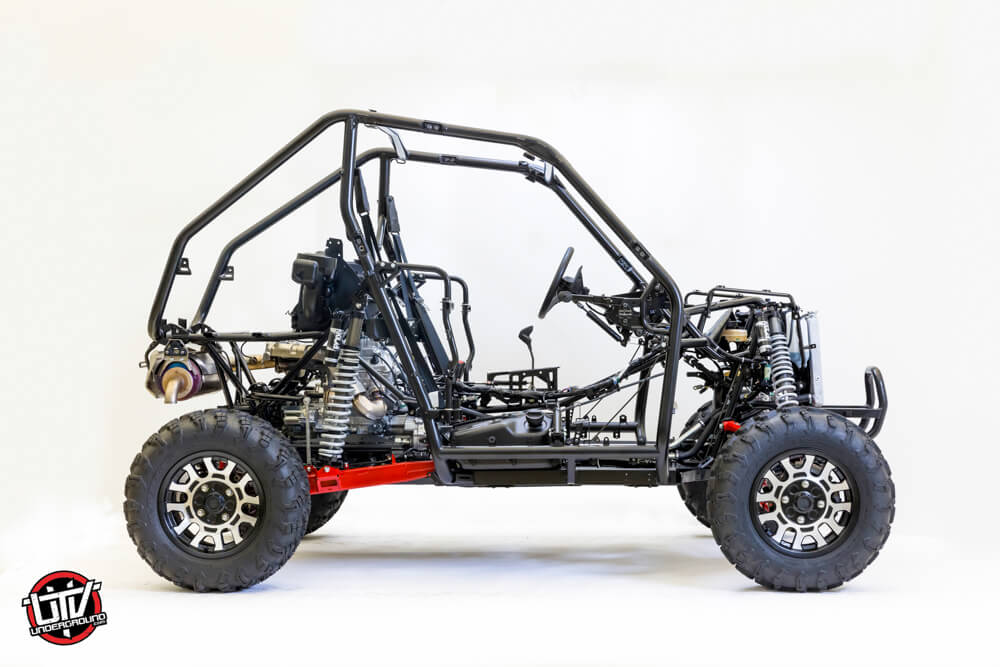 [gallery link="file" type="rectangular" ids="64304,64303,64302,64301,64300,64299,64298,64297,64296"]
The frame is a true one piece design, not bolted together, and is e-coat dipped, oven baked, and powder coated to ensure it’s bullet proof. The front suspension on both models is a double wishbone design. The 1000X has 14.6 inches of front-wheel travel with a 3 Link rear system and high-positioned trailing arm for improved ground clearance with 15.1 inches of rear travel. The Talon 1000R features 17.7 inches of front-wheel travel, a 4+ Link suspension design which limits toe change to only 0.3 degrees through the entire 20.1 inches of stroke, for excellent alignment control.
[gallery link="file" type="rectangular" ids="64304,64303,64302,64301,64300,64299,64298,64297,64296"]
The frame is a true one piece design, not bolted together, and is e-coat dipped, oven baked, and powder coated to ensure it’s bullet proof. The front suspension on both models is a double wishbone design. The 1000X has 14.6 inches of front-wheel travel with a 3 Link rear system and high-positioned trailing arm for improved ground clearance with 15.1 inches of rear travel. The Talon 1000R features 17.7 inches of front-wheel travel, a 4+ Link suspension design which limits toe change to only 0.3 degrees through the entire 20.1 inches of stroke, for excellent alignment control.
 Both models are equipped with Fox Podium Quick Switch 3 shocks. The 1000X uses a 2.0 inch-body shock for quick response, and the Talon 1000R is outfitted with 2.5 inch-body shocks for minimal fade during aggressive driving, along with robust 7/8 inch rods (vs. 5/8 inches) to handle high loads. The shocks use dual-rate springs at each wheel for a progressive suspension feel, with plushness at the beginning of the stroke and strong holdup and stability near the end of the stroke.
Honda went with a very user-friendly QS3 adjustment system and we’re glad they did. For those of us who are not racers the tool-less selection between three significantly different damping settings (comfort, sport, and aggressive/loaded) is awesome. This simplified tuning system encourages adjustment for changing conditions and also allows a quick visual check to ensure all ends are running the same settings. It’s not computer controlled - is human controlled, and many times that’s a better option.
Both models are equipped with Fox Podium Quick Switch 3 shocks. The 1000X uses a 2.0 inch-body shock for quick response, and the Talon 1000R is outfitted with 2.5 inch-body shocks for minimal fade during aggressive driving, along with robust 7/8 inch rods (vs. 5/8 inches) to handle high loads. The shocks use dual-rate springs at each wheel for a progressive suspension feel, with plushness at the beginning of the stroke and strong holdup and stability near the end of the stroke.
Honda went with a very user-friendly QS3 adjustment system and we’re glad they did. For those of us who are not racers the tool-less selection between three significantly different damping settings (comfort, sport, and aggressive/loaded) is awesome. This simplified tuning system encourages adjustment for changing conditions and also allows a quick visual check to ensure all ends are running the same settings. It’s not computer controlled - is human controlled, and many times that’s a better option.
 For the rubber Honda teamed up with Maxxis and built a 28 x 9-15 front and 28 x 11-15 Talon specific tire. This is probably our one area of “meh” in terms of wanting both a bigger set-up, as well as wanting four uniform tires to allow for a universal spare on the trail. If we had this UTV in the shop today we would be experimenting with different tire setups - and likely looking at a new more aggressive cage design, and that says a lot about this vehicle. There’s not much we would change right off the bat.
Honda could have slapped standard brakes on this machine and no one would have complained. Instead the Talon utilizes 34mm twin-piston front calipers and 34mm single-piston rear calipers, with 250mm brake rotors at all corners. The system uses low-expansion brake hoses and a 17mm master cylinder. The brake pads feature a new compound developed to achieve performance-level friction and feel, along with excellent wear life. Brake noise is reduced through the placement of rubber shims between the brake pads and calipers/pistons.
Even the pedal was given careful consideration, resulting in a trapezoid shape and a position that’s 4.3 inches to the side of and 1.3 inches back from the accelerator pedal, for seamless transitioning between the foot controls. What does all that mean? This machine stops on a dime - and when it’s doing so, it doesn’t swath out or get all wonky on you. That’s huge. There’s nothing worse than that last minute nightmarish steering flutter to try to keep your ride from hitting something when you slam on the brakes. But there’s even more to the braking story...as this ties in to how Honda developed their four wheel drive system.
For the rubber Honda teamed up with Maxxis and built a 28 x 9-15 front and 28 x 11-15 Talon specific tire. This is probably our one area of “meh” in terms of wanting both a bigger set-up, as well as wanting four uniform tires to allow for a universal spare on the trail. If we had this UTV in the shop today we would be experimenting with different tire setups - and likely looking at a new more aggressive cage design, and that says a lot about this vehicle. There’s not much we would change right off the bat.
Honda could have slapped standard brakes on this machine and no one would have complained. Instead the Talon utilizes 34mm twin-piston front calipers and 34mm single-piston rear calipers, with 250mm brake rotors at all corners. The system uses low-expansion brake hoses and a 17mm master cylinder. The brake pads feature a new compound developed to achieve performance-level friction and feel, along with excellent wear life. Brake noise is reduced through the placement of rubber shims between the brake pads and calipers/pistons.
Even the pedal was given careful consideration, resulting in a trapezoid shape and a position that’s 4.3 inches to the side of and 1.3 inches back from the accelerator pedal, for seamless transitioning between the foot controls. What does all that mean? This machine stops on a dime - and when it’s doing so, it doesn’t swath out or get all wonky on you. That’s huge. There’s nothing worse than that last minute nightmarish steering flutter to try to keep your ride from hitting something when you slam on the brakes. But there’s even more to the braking story...as this ties in to how Honda developed their four wheel drive system.
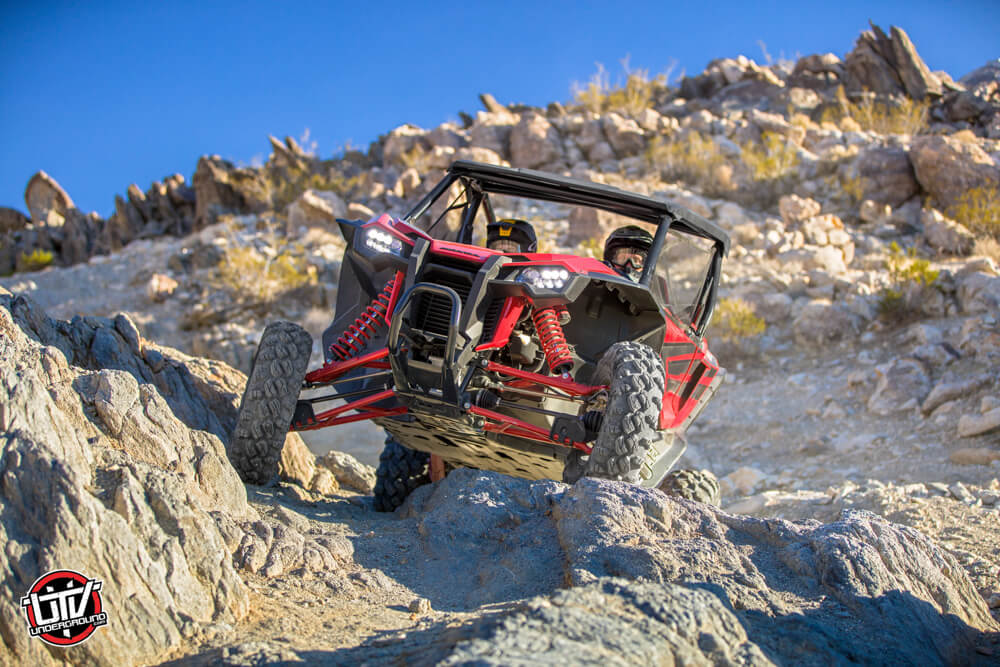 Honda’s I-4WD, introduced on the Pioneer 1000 LE, is the powersports industry’s first and only off-road brake traction control system (BTCS), and it has been specifically adapted to sport UTV use for the Talon. The system manages the amount of slip between left and right front wheels, applying torque to the wheel with greater grip. The result is excellent traction and tracking performance in tough off-road conditions, with reduced steer effort and kickback compared to a standard differential lock. The system also incorporates an Electronic Brakeforce Distribution system (EBD), which strategically applies braking force to optimize stability under braking, minimizing rear-chassis lift when in two-wheel drive. They even came up with a nifty way to simplify re-starting after stopping on steep ascents. The driver has the option of pressing a Hill Start Assist button (HSA) on the dash, thereby temporarily holding the vehicle in place without needing to apply pressure on the brake pedal. The system can hold the vehicle, fully loaded with passengers, on a 60% slope. As a separate feature, when the driver brakes aggressively, the vehicle holds gears longer for real engine braking.
Honda put all that attention just into the braking and four wheel drive systems for a vehicle that is going to cost below $20K? Are you kidding me? If that’s not raising the bar we don’t know what is. This is what happens when a company with such high automotive standards gets into the Sport UTV game and it’s likely going to push ALL of the other OEM’s to play catch up.
Honda’s I-4WD, introduced on the Pioneer 1000 LE, is the powersports industry’s first and only off-road brake traction control system (BTCS), and it has been specifically adapted to sport UTV use for the Talon. The system manages the amount of slip between left and right front wheels, applying torque to the wheel with greater grip. The result is excellent traction and tracking performance in tough off-road conditions, with reduced steer effort and kickback compared to a standard differential lock. The system also incorporates an Electronic Brakeforce Distribution system (EBD), which strategically applies braking force to optimize stability under braking, minimizing rear-chassis lift when in two-wheel drive. They even came up with a nifty way to simplify re-starting after stopping on steep ascents. The driver has the option of pressing a Hill Start Assist button (HSA) on the dash, thereby temporarily holding the vehicle in place without needing to apply pressure on the brake pedal. The system can hold the vehicle, fully loaded with passengers, on a 60% slope. As a separate feature, when the driver brakes aggressively, the vehicle holds gears longer for real engine braking.
Honda put all that attention just into the braking and four wheel drive systems for a vehicle that is going to cost below $20K? Are you kidding me? If that’s not raising the bar we don’t know what is. This is what happens when a company with such high automotive standards gets into the Sport UTV game and it’s likely going to push ALL of the other OEM’s to play catch up.
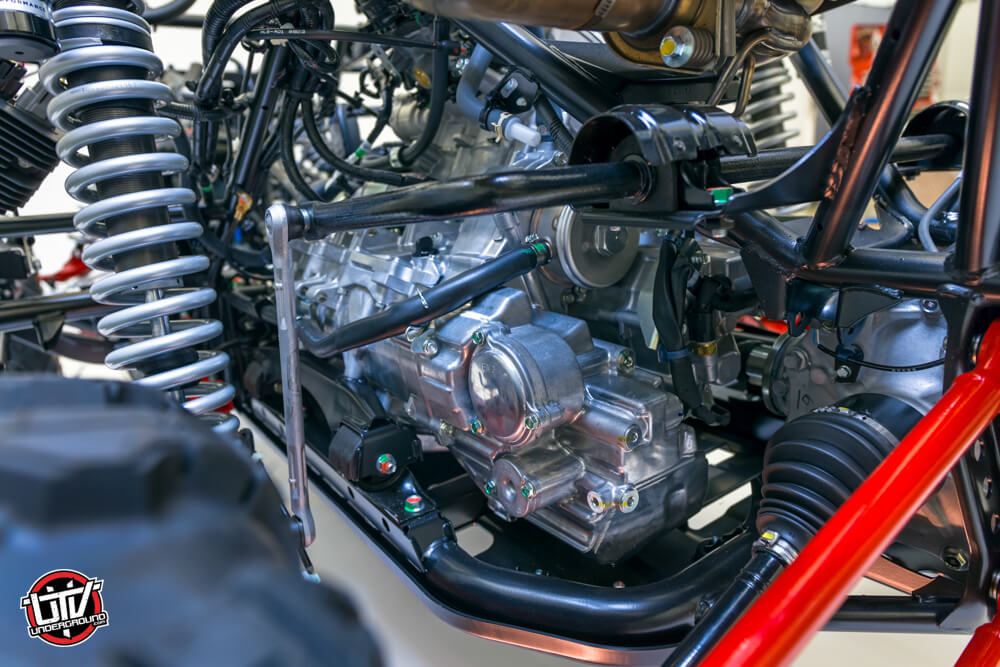 Engine & Drivetrain. Let’s talk motor, power, and transmission. Both Talon versions share the same 999cc four-valve Unicam® parallel-twin engine, a performance-tuned version of the platform from the durable Pioneer 1000 multipurpose UTV and CRF1000L Africa Twin adventure motorcycle. Developed in Japan by Honda Motor, and produced at the Kumamoto plant, the water-cooled engine features a 270 degree crossplane crankshaft.
[gallery type="rectangular" link="file" ids="64318,64317,64316,64315,64314,64313,64312"]
Bore-and-stroke specifications are an over-square 92 x 75.2mm, and a “spiny sleeve” cylinder has small protrusions on its outer surface, enhancing the adhesion between the steel sleeve and the aluminum barrel. This leads to improved cooling and a reduction in the bore distortion commonly caused by the dissimilar expansion rates of the two materials, so blow-by gas and oil consumption are minimized. An all-new cylinder head delivers increased performance.
Engine & Drivetrain. Let’s talk motor, power, and transmission. Both Talon versions share the same 999cc four-valve Unicam® parallel-twin engine, a performance-tuned version of the platform from the durable Pioneer 1000 multipurpose UTV and CRF1000L Africa Twin adventure motorcycle. Developed in Japan by Honda Motor, and produced at the Kumamoto plant, the water-cooled engine features a 270 degree crossplane crankshaft.
[gallery type="rectangular" link="file" ids="64318,64317,64316,64315,64314,64313,64312"]
Bore-and-stroke specifications are an over-square 92 x 75.2mm, and a “spiny sleeve” cylinder has small protrusions on its outer surface, enhancing the adhesion between the steel sleeve and the aluminum barrel. This leads to improved cooling and a reduction in the bore distortion commonly caused by the dissimilar expansion rates of the two materials, so blow-by gas and oil consumption are minimized. An all-new cylinder head delivers increased performance.
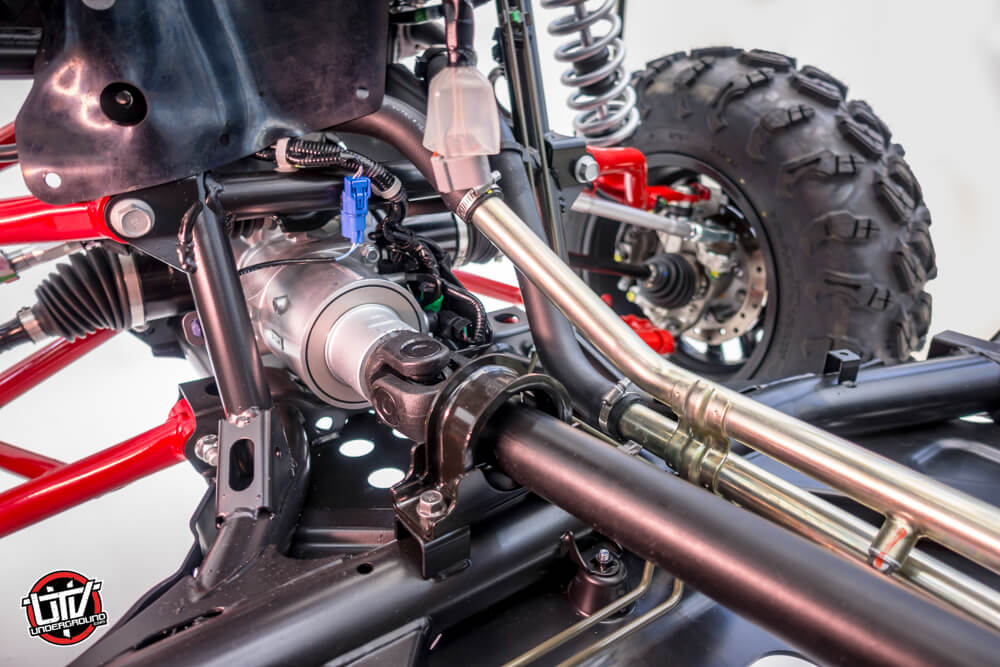 The engine is mounted longitudinally in the frame, eliminating unnecessary right angles in the driveline so that an efficient transfer of power to the rear wheels is possible, resulting in strong acceleration. The Talon can be switched between two-wheel-drive or four-wheel-drive on the fly, and even during situations of wheel spin, via a dash-mounted switch. We tested it. It works really damn well. So if you’re keeping track, that’s another innovative move. To reduce engine vibration transmitted to the chassis, yet also withstand the abuse of “spirited” driving, the engine is attached to the frame utilizing four rubber mounts. Oh look, another car company extra!
The engine is mounted longitudinally in the frame, eliminating unnecessary right angles in the driveline so that an efficient transfer of power to the rear wheels is possible, resulting in strong acceleration. The Talon can be switched between two-wheel-drive or four-wheel-drive on the fly, and even during situations of wheel spin, via a dash-mounted switch. We tested it. It works really damn well. So if you’re keeping track, that’s another innovative move. To reduce engine vibration transmitted to the chassis, yet also withstand the abuse of “spirited” driving, the engine is attached to the frame utilizing four rubber mounts. Oh look, another car company extra!
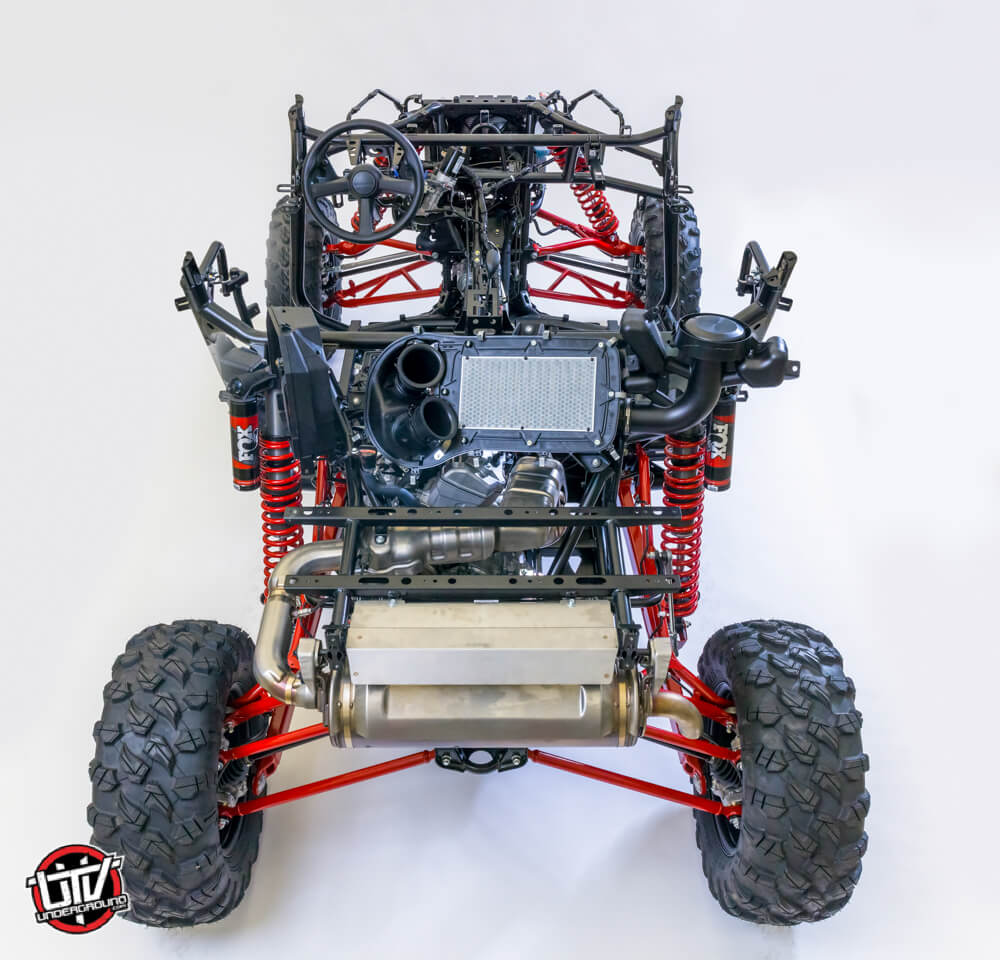 Honda used super fancy and expensive simulation engineering software, to design a new intake-port shape for improved airflow at the point of cylinder entry, resulting in increases in both power and fuel economy. Coupled with larger fuel-injection nozzles that each flow 18% more fuel, as well as a throttle body bore that is 9% larger, the reliable system produces performance-tuned power levels. To minimize reciprocating mass in the cylinder head, the engine employs an arrangement similar to that of the CRF450R motocrosser, with a Unicam® valve-train configuration and four valves per cylinder. Roller rocker arms have friction-reducing bearings where they contact their own cam lobes. Valve adjustment is via a shim-under-bucket arrangement. The new cam profile allows increased valve lift and duration; intake lift is increased by 2.5mm, with 25 degrees longer duration, while exhaust lift is increased by 2.2mm, with duration a full 45 degrees longer.
Honda used super fancy and expensive simulation engineering software, to design a new intake-port shape for improved airflow at the point of cylinder entry, resulting in increases in both power and fuel economy. Coupled with larger fuel-injection nozzles that each flow 18% more fuel, as well as a throttle body bore that is 9% larger, the reliable system produces performance-tuned power levels. To minimize reciprocating mass in the cylinder head, the engine employs an arrangement similar to that of the CRF450R motocrosser, with a Unicam® valve-train configuration and four valves per cylinder. Roller rocker arms have friction-reducing bearings where they contact their own cam lobes. Valve adjustment is via a shim-under-bucket arrangement. The new cam profile allows increased valve lift and duration; intake lift is increased by 2.5mm, with 25 degrees longer duration, while exhaust lift is increased by 2.2mm, with duration a full 45 degrees longer.
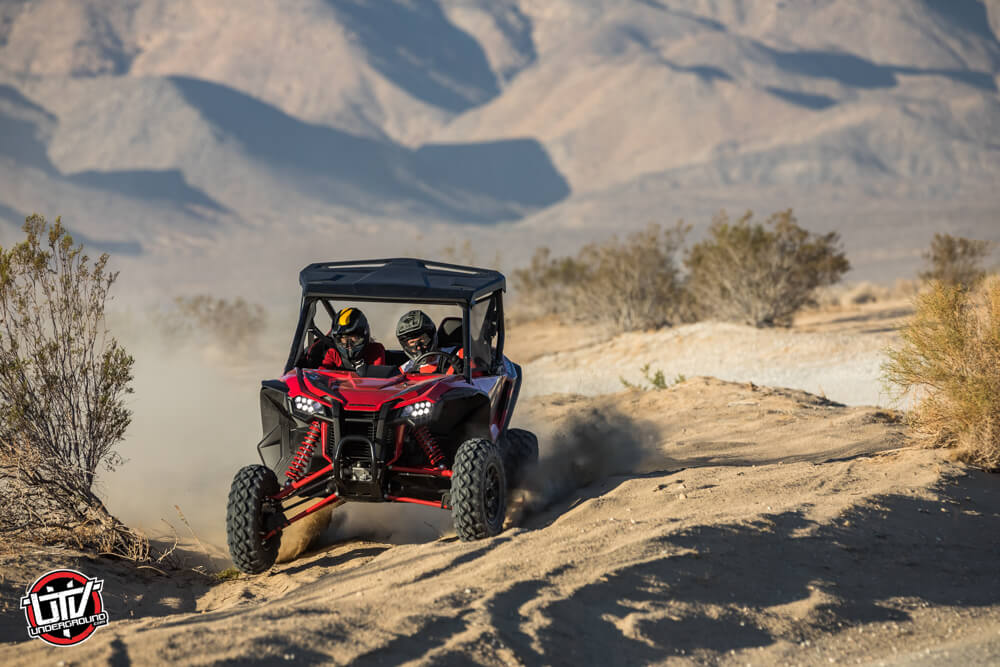 WHEW….ok but how does it FEEL? She’s got swagger people. Look it’s no secret we at UTVUnderground are big boys. I’m north of 260lbs on a good day walking down hill, so when I get in a UTV if it’s underpowered I feel it immediately. When we drove the Talon I was frankly shocked by the power map. These machines do not feel like 104hp - more like 130. The top end especially had a ton of room to give and when we did vertical hill climb driving the Talon danced up the steep inclines, over thick shale, with no hiccups in 4wd Sport Mode. Super impressive. When driving the Talon we never felt wanting for power. It’s a shake up in the works.
Honda did something special with the sound of this machine. Three resonators—each tuned for a different frequency—deliver a strong, exciting air-intake sound, and a connector between the twin exhaust headers tunes the exhaust note for a richer tone. Between that and the sound of the transmission shifting automatically it’s a much cooler feel than a normal CVT sound.
WHEW….ok but how does it FEEL? She’s got swagger people. Look it’s no secret we at UTVUnderground are big boys. I’m north of 260lbs on a good day walking down hill, so when I get in a UTV if it’s underpowered I feel it immediately. When we drove the Talon I was frankly shocked by the power map. These machines do not feel like 104hp - more like 130. The top end especially had a ton of room to give and when we did vertical hill climb driving the Talon danced up the steep inclines, over thick shale, with no hiccups in 4wd Sport Mode. Super impressive. When driving the Talon we never felt wanting for power. It’s a shake up in the works.
Honda did something special with the sound of this machine. Three resonators—each tuned for a different frequency—deliver a strong, exciting air-intake sound, and a connector between the twin exhaust headers tunes the exhaust note for a richer tone. Between that and the sound of the transmission shifting automatically it’s a much cooler feel than a normal CVT sound.
 The dry-sump engine design pulls oil from below the crank and into an integrated tank, and is engineered to circulate oil at a consistent rate even during aggressive cornering, jumping, climbing, descending and in rough conditions. In addition to the valve-train oil injectors, the new engine incorporates two multi-point oil jets, one beneath each piston, to spray four-stream jets of oil. This improves power and durability by lowering piston temperatures.
The dry-sump engine design pulls oil from below the crank and into an integrated tank, and is engineered to circulate oil at a consistent rate even during aggressive cornering, jumping, climbing, descending and in rough conditions. In addition to the valve-train oil injectors, the new engine incorporates two multi-point oil jets, one beneath each piston, to spray four-stream jets of oil. This improves power and durability by lowering piston temperatures.
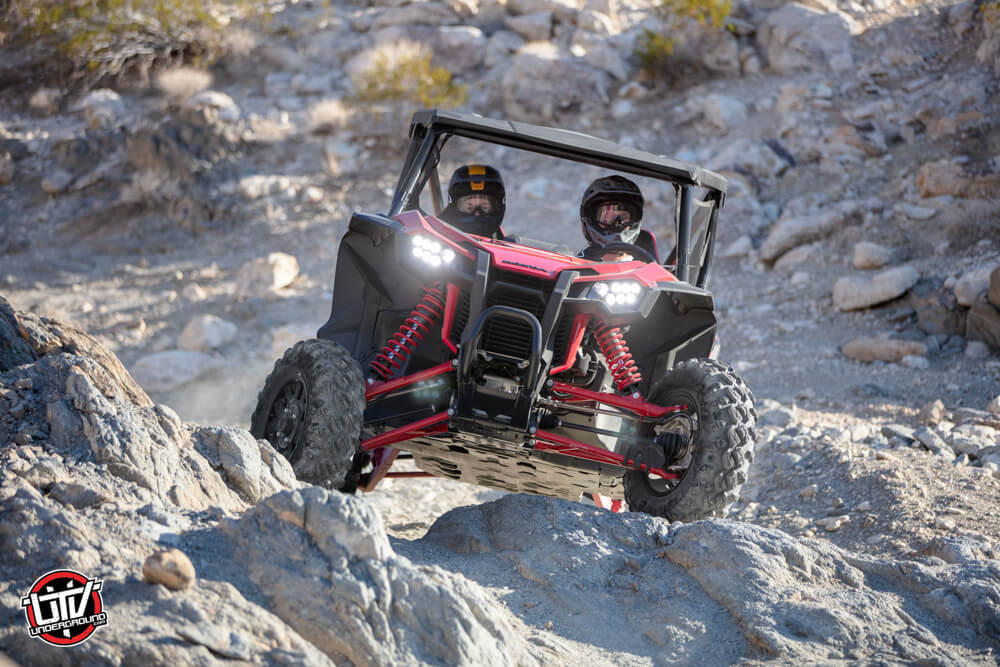 To keep the engine operating within its optimum temperature range, the new cooling system uses the highest-capacity cooling fan and radiator of any Honda ATV or UTV; the radiator is 1.1 inches thick, and its face measures 15.7 inches by 14.2 inches. Increasing efficiency at the low speeds common in technical sport UTV driving, a 13.4 inch, eight-blade fan pulls air through the radiator. Honda spent hours driving these machines in the dunes in the middle of the summer and they couldn’t get them to overheat. I’m sure we’ll all figure out a way to make that happen, but it’s good to know they understand how important temp maintenance is. I guess that comes with making more than 25 million motors.
To keep the engine operating within its optimum temperature range, the new cooling system uses the highest-capacity cooling fan and radiator of any Honda ATV or UTV; the radiator is 1.1 inches thick, and its face measures 15.7 inches by 14.2 inches. Increasing efficiency at the low speeds common in technical sport UTV driving, a 13.4 inch, eight-blade fan pulls air through the radiator. Honda spent hours driving these machines in the dunes in the middle of the summer and they couldn’t get them to overheat. I’m sure we’ll all figure out a way to make that happen, but it’s good to know they understand how important temp maintenance is. I guess that comes with making more than 25 million motors.
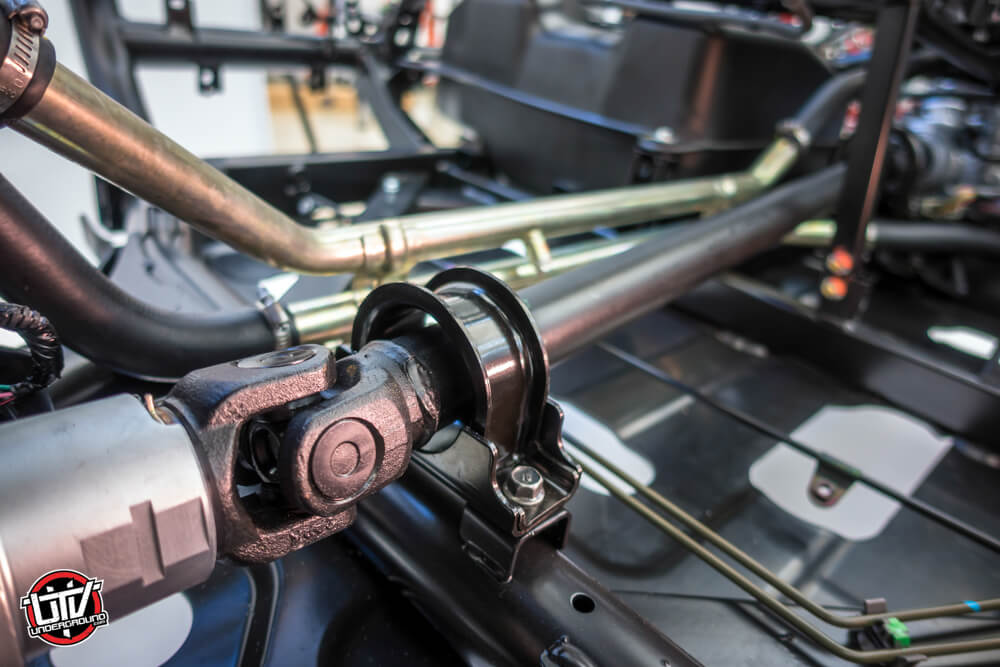 The Talon has the largest-in-class driveshaft, and really robust U-Joints. The driveshaft components have been positioned up high in the chassis, maximizing ground clearance and reducing susceptibility to damage. Honda utilized a spiral bevel gear for reduced whine compared to a straight-cut gear, a first for any of their powersports products.
Dual Clutch Transmission. Let’s talk about this transmission. Honda debuted the Dual Clutch Transmission (DCT) for production powersports use on the 2010 VFR1200F sport-touring motorcycle, and while similar systems can be found in a number of high-performance sports cars, DCT remains a Honda exclusive in motorcycles, ATVs, and UTV’s
The Talon has the largest-in-class driveshaft, and really robust U-Joints. The driveshaft components have been positioned up high in the chassis, maximizing ground clearance and reducing susceptibility to damage. Honda utilized a spiral bevel gear for reduced whine compared to a straight-cut gear, a first for any of their powersports products.
Dual Clutch Transmission. Let’s talk about this transmission. Honda debuted the Dual Clutch Transmission (DCT) for production powersports use on the 2010 VFR1200F sport-touring motorcycle, and while similar systems can be found in a number of high-performance sports cars, DCT remains a Honda exclusive in motorcycles, ATVs, and UTV’s
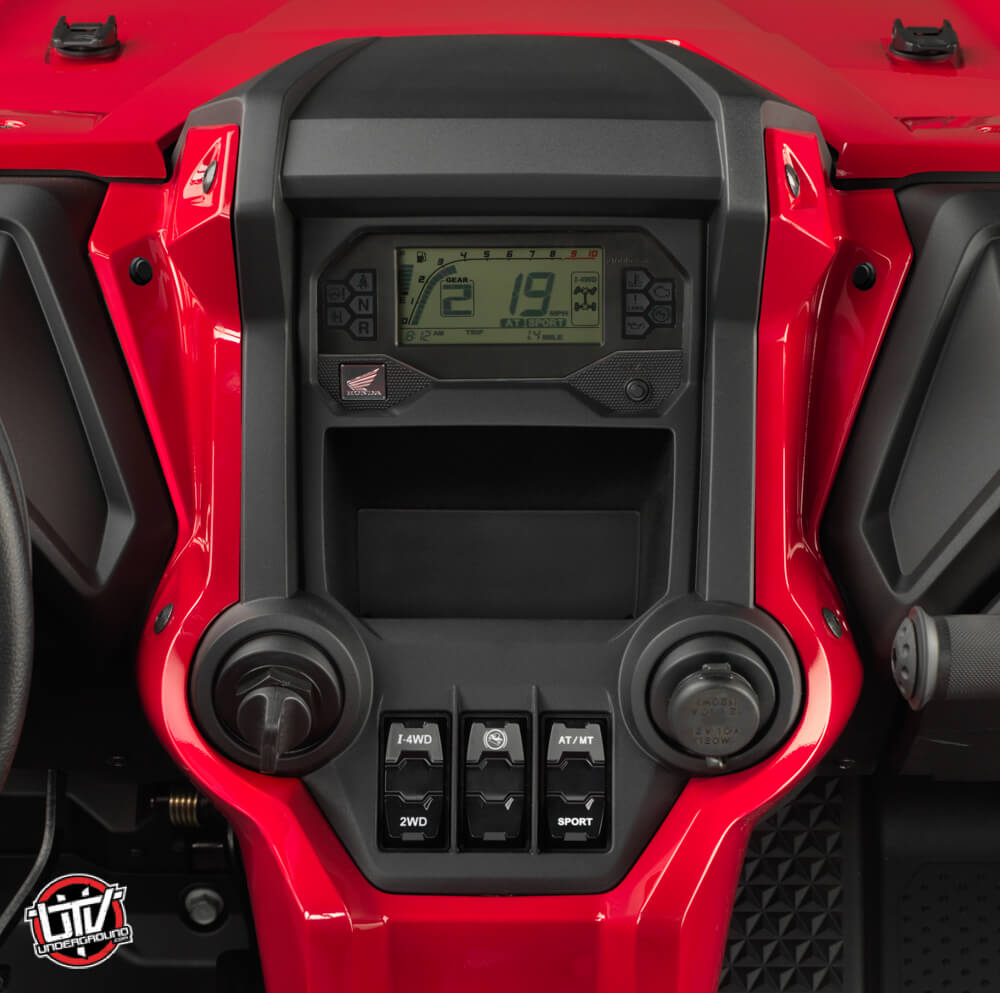 DCT uses two clutches that are controlled by sophisticated electronics and hydraulics. One clutch, which rides on a hollow outer shaft, controls odd-numbered gear sets (1, 3, 5); the other clutch rides on an inner shaft and controls even-numbered gear sets (2, 4, 6). Multiple gears are engaged simultaneously so that the transmission is constantly prepared for the next shift.
DCT uses two clutches that are controlled by sophisticated electronics and hydraulics. One clutch, which rides on a hollow outer shaft, controls odd-numbered gear sets (1, 3, 5); the other clutch rides on an inner shaft and controls even-numbered gear sets (2, 4, 6). Multiple gears are engaged simultaneously so that the transmission is constantly prepared for the next shift.
 Data, collected by a series of sensors, is processed by the ECU, which uses an advanced algorithm to determine when the shift-control motor should electronically trigger gear-changes. At those moments, one clutch disengages and the other engages, resulting in shifts that are quick, smooth and seamless. A geared transmission that shifts automatically, DCT enables a direct, connected feeling between the foot pedal and the rear wheels, as well as an efficient transfer of power. It also boasts durability, flexibility, true engine braking, and quick, smooth gear changes.
Data, collected by a series of sensors, is processed by the ECU, which uses an advanced algorithm to determine when the shift-control motor should electronically trigger gear-changes. At those moments, one clutch disengages and the other engages, resulting in shifts that are quick, smooth and seamless. A geared transmission that shifts automatically, DCT enables a direct, connected feeling between the foot pedal and the rear wheels, as well as an efficient transfer of power. It also boasts durability, flexibility, true engine braking, and quick, smooth gear changes.
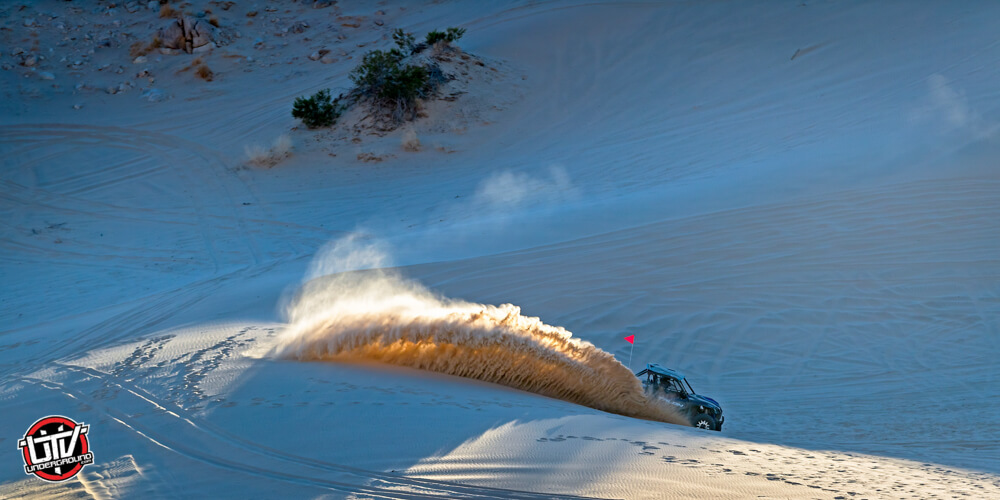 So there’s no belt? Correct. No belt. No chain. Nothing to replace on the trail. It’s a direct connection so you will never need to crack it open and mess with it. STELLAR. If we had all of the hours back we’ve sat around waiting for a belt swap...
The Talon’s six-speed DCT offers two fully automatic modes, Drive and Sport. The former allows the engine to operate at a lower rpm, for relaxed driving or in situations where reducing load on the drivetrain results in smoother driving over rough terrain, and the latter holds gears longer, shifting up or down at higher rpm for more aggressive driving. There’s also a Manual mode that gives the driver full control over the transmission, enabling him or her to change gears up or down via a pair of easily reachable, steering-wheel-mounted paddles, for heads-up driving. Even when driving in either of the two automatic modes, the system can be overridden via use of these paddles, with the transmission returning to automatic mode several seconds after each shift.
So there’s no belt? Correct. No belt. No chain. Nothing to replace on the trail. It’s a direct connection so you will never need to crack it open and mess with it. STELLAR. If we had all of the hours back we’ve sat around waiting for a belt swap...
The Talon’s six-speed DCT offers two fully automatic modes, Drive and Sport. The former allows the engine to operate at a lower rpm, for relaxed driving or in situations where reducing load on the drivetrain results in smoother driving over rough terrain, and the latter holds gears longer, shifting up or down at higher rpm for more aggressive driving. There’s also a Manual mode that gives the driver full control over the transmission, enabling him or her to change gears up or down via a pair of easily reachable, steering-wheel-mounted paddles, for heads-up driving. Even when driving in either of the two automatic modes, the system can be overridden via use of these paddles, with the transmission returning to automatic mode several seconds after each shift.
 Stop. Stop right there. The paddle shifters work in any mode? Yes. Remember our comments earlier about the braking system? One of the coolest things we experienced while testing these vehicles was using the paddle shift system to downshift instead of stabbing the brake pedal or left foot braking. If you’re a fan of rally racing, Formula 1, or IMSA you know what I mean. It is a TON of fun to drop a gear for power and acceleration and when needed, or for downhill braking. So think of it this way - the paddle shifting is for moderate braking and rapid acceleration changes. You are making a fairly mellow, (planned) turn for example...shift down and turn. No need to stab the brakes. No need to touch the brakes. Keep your foot on the gas. Or let's say you want to override the automatic transmission and drop a gear for quick power. Easy. Grab the left shifter paddle. The kick-ass braking system comes into play more when it’s unplanned braking. Stuff that comes up much faster. Not hitting a deer or seeing an obstacle ahead. Here’s the rad thing - you don’t have to worry about smoking the transmission when using the paddles. The computer does the work for you and won’t let you do anything stupid! We absolutely loved this feature, it’s super intuitive. The paddles are robust feeling and the perfect shape and size. This really is a game changer and just made driving these machines that much more fun.
The Talon’s DCT has high oil flow to the clutch to minimize heat, and the dash has a clutch-temperature indicator. The Talon also has a sub-transmission that provides high and low transmission ranges, effectively doubling the number of gears. During acceleration, the Talon’s DCT provides the visceral and audible thrill of running through the gears with a sport-oriented feel and sound, no matter the selected mode. In addition, the Ignition Feedback Control system allows for quick torque reduction during shifting, for fast, precise gear changes. Even the reverse gear has been optimized for Sport use for easily exiting from tight situations.
Stop. Stop right there. The paddle shifters work in any mode? Yes. Remember our comments earlier about the braking system? One of the coolest things we experienced while testing these vehicles was using the paddle shift system to downshift instead of stabbing the brake pedal or left foot braking. If you’re a fan of rally racing, Formula 1, or IMSA you know what I mean. It is a TON of fun to drop a gear for power and acceleration and when needed, or for downhill braking. So think of it this way - the paddle shifting is for moderate braking and rapid acceleration changes. You are making a fairly mellow, (planned) turn for example...shift down and turn. No need to stab the brakes. No need to touch the brakes. Keep your foot on the gas. Or let's say you want to override the automatic transmission and drop a gear for quick power. Easy. Grab the left shifter paddle. The kick-ass braking system comes into play more when it’s unplanned braking. Stuff that comes up much faster. Not hitting a deer or seeing an obstacle ahead. Here’s the rad thing - you don’t have to worry about smoking the transmission when using the paddles. The computer does the work for you and won’t let you do anything stupid! We absolutely loved this feature, it’s super intuitive. The paddles are robust feeling and the perfect shape and size. This really is a game changer and just made driving these machines that much more fun.
The Talon’s DCT has high oil flow to the clutch to minimize heat, and the dash has a clutch-temperature indicator. The Talon also has a sub-transmission that provides high and low transmission ranges, effectively doubling the number of gears. During acceleration, the Talon’s DCT provides the visceral and audible thrill of running through the gears with a sport-oriented feel and sound, no matter the selected mode. In addition, the Ignition Feedback Control system allows for quick torque reduction during shifting, for fast, precise gear changes. Even the reverse gear has been optimized for Sport use for easily exiting from tight situations.
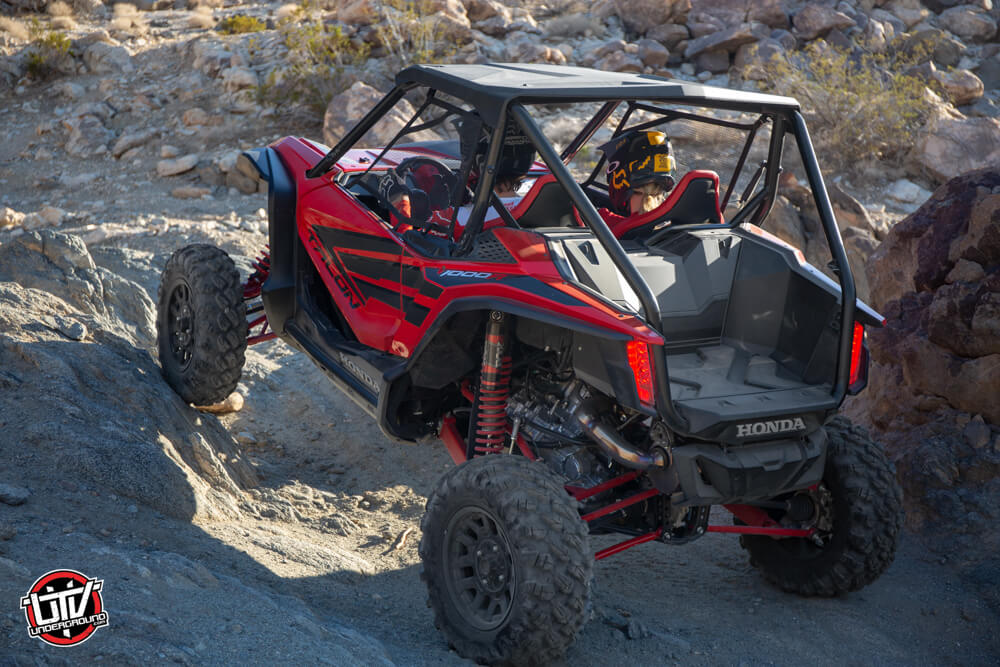 So what’s the consensus on this machine? Honda has a winner here folks. This is a rock solid machine and one that’s going to be a serious contender in the 64”+ multisport category. As we sit here finishing this article and preparing all the cool Talon photos and videos, we still don’t know the list price and ship date. Rumors are sub $20K and early spring, but we’ll know in less than twenty-four hours. Honda being Honda, they are debuting the Talon during the LA Auto show alongside a new SUV. Another innovative and bold move. Put the new Talon on a stage with a new SUV model in front of a very sophisticated automotive crowd? Classy. And just the kind of mainstream attention our industry needs.
Howard Cosell once said “The ultimate victory in competition is derived from the inner satisfaction of knowing that you have done your best, and that you have gotten the most out of what you had to give.” It’s very evident that the Team at Honda have done just that. Congratulations to Assistant Manager of Powersports Communication Jon Seidel, Joe Gilkerson and Wayne Lambert in 4W Product Planning, Senior Designer Erik Dunshee, Chassis Designer Dustin Schroeder, Dane Marsack in Marketability Testing, Mike Dickinson in Powertrain Controls Testing, Brandon Ricketts in Handling and Stability Testing, Matt Joseph, Drey Dircks, and LPL Chief Engineer Jeremy McGuire. And a special thank you to Ben Hoang in 4W Media Communications for the invitation to the exclusive early media launch at the Honda Proving Center. Stay tuned as we look forward to getting our very own UTVUnderground Talon build underway very soon!
So what’s the consensus on this machine? Honda has a winner here folks. This is a rock solid machine and one that’s going to be a serious contender in the 64”+ multisport category. As we sit here finishing this article and preparing all the cool Talon photos and videos, we still don’t know the list price and ship date. Rumors are sub $20K and early spring, but we’ll know in less than twenty-four hours. Honda being Honda, they are debuting the Talon during the LA Auto show alongside a new SUV. Another innovative and bold move. Put the new Talon on a stage with a new SUV model in front of a very sophisticated automotive crowd? Classy. And just the kind of mainstream attention our industry needs.
Howard Cosell once said “The ultimate victory in competition is derived from the inner satisfaction of knowing that you have done your best, and that you have gotten the most out of what you had to give.” It’s very evident that the Team at Honda have done just that. Congratulations to Assistant Manager of Powersports Communication Jon Seidel, Joe Gilkerson and Wayne Lambert in 4W Product Planning, Senior Designer Erik Dunshee, Chassis Designer Dustin Schroeder, Dane Marsack in Marketability Testing, Mike Dickinson in Powertrain Controls Testing, Brandon Ricketts in Handling and Stability Testing, Matt Joseph, Drey Dircks, and LPL Chief Engineer Jeremy McGuire. And a special thank you to Ben Hoang in 4W Media Communications for the invitation to the exclusive early media launch at the Honda Proving Center. Stay tuned as we look forward to getting our very own UTVUnderground Talon build underway very soon!
Honda Talon 1000R Beauty Photos
[gallery link="file" ids="64327,64328,64329,64330,64331,64332,64333,64334,64335,64336,64337,64338"]
Honda Talon 1000R Interior
[gallery link="file" ids="64512,64513,64514,64515,64516,64517,64518,64519,64520,64521,64522,64523"]
Honda Talon 1000R Details
[gallery link="file" ids="64339,64340,64341,64342,64343,64345,64347,64348,64349,64350,64354,64355,64357,64358,64359,64361,64362,64367,64368,64370,64374,64376,64377,64378,64379,64380,64381,64382,64383,64384,64385,64386,64387,64388,64389,64390,64391,64394,64395,64396,64397,64398,64399,64400,64352"]
Honda Talon 1000R Action
[gallery link="file" ids="64403,64404,64405,64406,64407,64408,64409,64410,64411,64412,64413,64414,64415,64416,64417,64418,64419,64420,64421,64422,64423,64424,64425,64426,64427,64428"]
Honda Talon 1000X Beauty Photos
[gallery link="file" ids="64429,64430,64431,64432,64433,64434,64435,64436,64437,64438,64439,64440"]
Honda Talon 1000X Interior
[gallery link="file" ids="64511,64510,64509,64508,64507"]
Honda Talon 1000RX Details
[gallery link="file" ids="64448,64506,64505,64504,64503,64502,64501,64500,64499,64498,64497,64495,64494,64493,64491,64490,64489,64488,64487,64486,64483,64482,64481,64479,64477,64476,64474,64473,64472,64471,64470,64469,64468,64467,64466,64465,64464,64463,64462,64461,64459,64458,64457,64456,64455,64454,64452,64451,64450,64449"]
Honda Talon 1000X Action
[gallery link="file" ids="64441,64442,64443,64444,64445,64446,64447"]
 The Talon 14000R has a 4+ link trailing arm suspension setup and is about 5” wider all around with 2.5” Fox Podium QS3 shocks – perfect for the desert.[/caption]
Last year Honda’s Ohio engine plant celebrated the production of their twenty-five millionth engine, since opening the facility in 1985. Let that sink in for a second. That’s one plant, in the US - that has made 25 million motors. A few weeks ago, almost a year to the day, UTVUnderground was invited to the hallowed ground of the Honda Proving Center near Tehachapi California - to an exclusive advanced preview of not one, but two of the most anticipated new products from Honda in nearly a decade, the 2019 Honda Talon 1000R and 1000X. You may have seen the leaked photos. You may have heard the hype. Here is the definitive breakdown of the Honda Talon. This is one machine you will want to drive as soon as is humanly possible. It’s that good.
https://youtu.be/G8WBdOkzWAQ
The new Honda Talon UTV is two machines - both 999cc and roughly 104 horsepower. The Talon 1000R has a 4+ link trailing arm suspension setup and is about 5” wider all around with 2.5” Fox Podium QS3 shocks - perfect for the desert. The Talon 1000X has a traditional 3 link setup, 2” Fox Podium QS3 shocks and is more agile/nimble and suited to the trails. Both are identical in every way except for their size and suspension.
[caption id="attachment_64232" align="aligncenter" width="1000"]
The Talon 14000R has a 4+ link trailing arm suspension setup and is about 5” wider all around with 2.5” Fox Podium QS3 shocks – perfect for the desert.[/caption]
Last year Honda’s Ohio engine plant celebrated the production of their twenty-five millionth engine, since opening the facility in 1985. Let that sink in for a second. That’s one plant, in the US - that has made 25 million motors. A few weeks ago, almost a year to the day, UTVUnderground was invited to the hallowed ground of the Honda Proving Center near Tehachapi California - to an exclusive advanced preview of not one, but two of the most anticipated new products from Honda in nearly a decade, the 2019 Honda Talon 1000R and 1000X. You may have seen the leaked photos. You may have heard the hype. Here is the definitive breakdown of the Honda Talon. This is one machine you will want to drive as soon as is humanly possible. It’s that good.
https://youtu.be/G8WBdOkzWAQ
The new Honda Talon UTV is two machines - both 999cc and roughly 104 horsepower. The Talon 1000R has a 4+ link trailing arm suspension setup and is about 5” wider all around with 2.5” Fox Podium QS3 shocks - perfect for the desert. The Talon 1000X has a traditional 3 link setup, 2” Fox Podium QS3 shocks and is more agile/nimble and suited to the trails. Both are identical in every way except for their size and suspension.
[caption id="attachment_64232" align="aligncenter" width="1000"] Honda Talon 1000R[/caption]
The Talon is built around a (DCT) dual clutch drivetrain which means no belts or chains. It’s an automatic 6-speed engine that sounds and feels like a real car thanks to clever tuning. It features a remarkable paddle shift system on the steering column that allows the driver the ability to bang gears like a World Rally Car and its intelligent 4-wheel drive system is way more advanced than just a simple locking diff. The dash, seats, doors, and interior components are incredibly refined and feel sturdy and finished.
Honda Talon 1000R[/caption]
The Talon is built around a (DCT) dual clutch drivetrain which means no belts or chains. It’s an automatic 6-speed engine that sounds and feels like a real car thanks to clever tuning. It features a remarkable paddle shift system on the steering column that allows the driver the ability to bang gears like a World Rally Car and its intelligent 4-wheel drive system is way more advanced than just a simple locking diff. The dash, seats, doors, and interior components are incredibly refined and feel sturdy and finished.
Honda Talon 1000R Action Shots
 [gallery type="rectangular" link="file" ids="64258,64260,64261,64262,64263,64264"]
How does it drive? In a word - AWESOME. It feels fast, powerful, solid, predictable, and the steering response is fantastic. It soaks up whoops and rutts and has lots of top end going uphill in the thick rock and shale. This machine, is an all around fantastic UTV, and exactly what you would expect from Honda. WIll it compete head to head with the Polaris RZR Turbo S and Can AM Maverick X3 Turbo R? No. But it’s not supposed to. But it packs a wallop of a punch in it’s category. Honda is going after the “multisport” segment and these Talon’s are a solid entry into the market for them, especially considering the specs of the 2019 Honda Talon.
[gallery type="rectangular" link="file" ids="64258,64260,64261,64262,64263,64264"]
How does it drive? In a word - AWESOME. It feels fast, powerful, solid, predictable, and the steering response is fantastic. It soaks up whoops and rutts and has lots of top end going uphill in the thick rock and shale. This machine, is an all around fantastic UTV, and exactly what you would expect from Honda. WIll it compete head to head with the Polaris RZR Turbo S and Can AM Maverick X3 Turbo R? No. But it’s not supposed to. But it packs a wallop of a punch in it’s category. Honda is going after the “multisport” segment and these Talon’s are a solid entry into the market for them, especially considering the specs of the 2019 Honda Talon.
2019 HONDA TALON SPECIFICATIONS
Engine Type: 999cc liquid-cooled Unicam® OHC longitudinally mounted parallel-twin four-stroke; four valves per cylinder Bore x Stroke: 92.0mm x 75.15mm Compression Ratio: 10.0:1 Induction: Fuel injection, 46mm throttle bodies Ignition: Full Transistorized Starter: Electric Driveline: Direct front and rear driveshafts Transmission: Six-speed automatic DCT + reverse and high/low sub-transmisson Clutch: 2-Multiplate Wet 1000R Front Suspension: Double wishbone; 17.7 in. travel, Fox Podium 2.5 with Quick Switch 3 1000R Rear Suspension: 4+ Link trailing arm; 20.1 in. travel, Fox Podium 2.5 with Quick Switch 3 1000X Front Suspension:Double wishbone; 14.6 in. travel, Fox Podium 2.0 with Quick Switch 3 1000X Rear Suspension:3 Link trailing arm; 15.1 in. travel, Fox Podium 2.0 with Quick Switch 3 Front Brakes: Hydraulic w/ two 250mm discs; Electronic Brakeforce Distribution (EBD) system Rear Brakes: Hydraulic w/ two 250mm discs; Electronic Brakeforce Distribution (EBD) system Front Tires: 28x9x15 Rear Tires: 28x11x15 Length: 123.9 in. 1000R Width: 68.4 1000X Width: 64.0 in. 1000R Height: 75.6 in. 1000X Height: 75.3 in. 1000R Seat Height: 28.3 in. 1000X Seat Height: 28.0 in. 1000R Ground Clearance: 13.0 in. 1000X Ground Clearance: 12.7 in. 1000R Wheelbase: 92.7 in. 1000X Wheelbase: 87.6 in. 1000R Turning Radius: 21.3 ft. 1000X Turning Radius: 17.7 ft. Fuel Capacity: 7.3 gal., including 1.1 gal. reserve Cargo Bed Capacity: 299 lbs. 1000R Curb Weight: 1,545 lbs. (1,548 lbs. CA) 1000X Curb Weight: 1,490 lbs. (1,492 lbs. CA) 1000R Colors: Pearl Red; Pearl Green 1000R Colors: Pearl Red/Metallic Grey; Metallic Grey/Metallic Blue *Includes all standard equipment, required fluids and full tank of fuel—ready to ride Meets current CARB and EPA off-road emissions standards Recommended for riders 16 years of age and olderClick here for a model comparison. Click here for design interview. Click here for chassis interview. Click here for testing interview. Click here for production interview.
 The Honda CR and CRF dirt bikes have been the gold standard for decades. And it’s from that world that these new machines were born. The Honda engineers and design team we met were basically given a blank canvas and told to build something that lived up to the Honda name. A machine that spoke to the tradition of the Honda dirt bike lineage, and they did just that. In fact it was early in the design process that the team of Jon Seidel, Joe Gilkerson, Wayne Lambert and Jeremy McGuire realized they couldn’t pack everything into one vehicle, and the 1000X and 1000R Talon’s were born.
The Honda CR and CRF dirt bikes have been the gold standard for decades. And it’s from that world that these new machines were born. The Honda engineers and design team we met were basically given a blank canvas and told to build something that lived up to the Honda name. A machine that spoke to the tradition of the Honda dirt bike lineage, and they did just that. In fact it was early in the design process that the team of Jon Seidel, Joe Gilkerson, Wayne Lambert and Jeremy McGuire realized they couldn’t pack everything into one vehicle, and the 1000X and 1000R Talon’s were born.
 [gallery type="rectangular" link="file" ids="64265,64266,64267,64268,64269,64270"]
Design. The Talon was designed at Honda R&D in Torrance, California and the vehicle is dominated by a high bodyline and a body side that has a continuous flow from front to rear. When looking at the machine it has a pronounced, strong stance, which was created by placing the four wheels at the extreme corners of the vehicle. To us when you look at the aggressive fenders and wheel wells it screams out for 32” tire - or bigger! The roof, which comes standard on the Talon, incorporates a front lip to keep moisture from reaching the interior (even when braking in rainy conditions), and a horizontal pass-through slit both creates a functional spoiler (providing downforce at higher speeds) and allows appropriate aerodynamics when the vehicle is towed on a trailer, whether it’s facing forward or backward. Leave it to Honda to improve on something as simple as a roof.
[gallery type="rectangular" link="file" ids="64265,64266,64267,64268,64269,64270"]
Design. The Talon was designed at Honda R&D in Torrance, California and the vehicle is dominated by a high bodyline and a body side that has a continuous flow from front to rear. When looking at the machine it has a pronounced, strong stance, which was created by placing the four wheels at the extreme corners of the vehicle. To us when you look at the aggressive fenders and wheel wells it screams out for 32” tire - or bigger! The roof, which comes standard on the Talon, incorporates a front lip to keep moisture from reaching the interior (even when braking in rainy conditions), and a horizontal pass-through slit both creates a functional spoiler (providing downforce at higher speeds) and allows appropriate aerodynamics when the vehicle is towed on a trailer, whether it’s facing forward or backward. Leave it to Honda to improve on something as simple as a roof.
Honda Talon 1000R Beauty Shots
[gallery link="file" ids="64233,64232,64234,64235,64237,64236,64240,64243,64242,64241,64239,64238"] The headlights are LED for long life and bright, uniform illumination, and feature high and low beam and the machines comes standard with full side nets that feature rigidly mounted buckles to make latching simple and quick, even with one hand. We love the lids on the hood, bed cover, battery cover, and fuse box, which can be opened without tools, again another simple design tweak that saves time in the garage and on the trail.Interior of the Honda Talon 1000R
[gallery type="rectangular" link="file" ids="64229,64228,64227,64230,64231"] Inside, the Talon really shines. The interior feels more like a car than a UTV pretending to be one. The sport seats are wide - comfortable, weather resistant, and adjustable using an automobile-grade slide mechanism with high-grade bearings. These do not feel like cheap throw away seats. They have traditional three-point seatbelts but come ready for a four-point belt system. A nice nod to the aftermarket. A full center console separates the driver and passenger compartments for a high-tech, cockpit-like feel, but the dash has a symmetrical layout that allows easy viewing of information by not just the driver, but the passenger as well. Colorful accents are an indicator of the level of thought, put into the interior’s design.Interior of the Honda Talon 1000X
[gallery type="rectangular" link="file" td_gallery_title_input="Interior of the Honda Talon 1000X" ids="64221,64222,64223,64224,64225"] The steering wheel is infinitely adjustable for tilt (electric power steering is standard). The passenger gets a door armrest and grab handle, along with a rattle-free, “handlebar,” complete with a quick-release adjustment lever that allows it to be easily and quickly telescoped in and out to accommodate varying physiques. Gone are the days of hunting for the stupid pinhole to adjust this important safety feature. There’s also a center foot rest area for relaxed riding comfort, and floor drains simplify the process of washing the vehicle. A 12V accessory adapter is standard, and even the cup holders are designed to securely hold containers of varying diameters including most insulated tumblers. The open bed style rear end of the Talon might throw some of you off at first. There’s no flip down bed like the Polaris General, and no molded bed like the RZR. But the fact is neither are going to keep your gear from going flying. The Talon bed is large enough for a big cooler, and six integrated tie-down points allow items to be secured for aggressive driving. They offer a soft bag that drops right in - which makes a ton of sense. A flag mount is incorporated into the rollover protection system. Nice little touches that add up.
The open bed style rear end of the Talon might throw some of you off at first. There’s no flip down bed like the Polaris General, and no molded bed like the RZR. But the fact is neither are going to keep your gear from going flying. The Talon bed is large enough for a big cooler, and six integrated tie-down points allow items to be secured for aggressive driving. They offer a soft bag that drops right in - which makes a ton of sense. A flag mount is incorporated into the rollover protection system. Nice little touches that add up.
Honda Talon 1000X Beauty Shots
[gallery link="file" ids="64273,64274,64275,64276,64277,64278,64279,64280,64281,64282,64283,64284"] The 1000X is available in red/gray with gray suspension accents and gray/blue with silver suspension accents, and the Talon 1000R is offered in red with gray accents and green with silver accents. The lightweight plastic body panels are coated with automotive-grade paint for a long-lasting, top-quality look. Overall we really like the design of the Talon. Does it look a little bit like a scrunched up Yamaha YXZ? A little bit yea. The front end isn’t as slanted as the YXZ, it almost has a Meyers Manx body line to it. But it feels like it should - like the trusty EU2200i Honda generator. Not too much flair or ridiculousness. Everything feels refined, like it has a purpose. Things like the interior door panels being finished and the quality of the seats speak to Honda’s automotive heritage. They’re definitely firing a shot across the bow of the other UTV makers with the refinements on the design. Do they have a big beautiful ipad sized navigation system like Polaris? Not yet. It’s a smaller screen with the HUD basics you would expect for a vehicle priced under $20K. But we wouldn’t be surprised if down the line there was a giant touchscreen option like they use in their minivans or higher end cars and SUV’s.Honda Talon 1000R Body Off Details
 [gallery type="rectangular" ids="64286,64287,64288,64289,64290,64291,64292,64293,64294"]
Chassis. So the Talon looks cool and feels refined and well built on the inside, but what about the guts - as in, does it have any? Yes. The frame and suspension components were engineered and developed for a plush ride, maximum ground clearance and precise steering response. The frame itself is identical in both models, but the Talon 1000X’s suspension and wheelbase are intended to emphasize maneuverability and precise handling, (trail riding) while the Talon 1000R’s are tilted more toward high-speed tracking and large bump absorption; (desert racing and rock bouncing).
[gallery type="rectangular" ids="64286,64287,64288,64289,64290,64291,64292,64293,64294"]
Chassis. So the Talon looks cool and feels refined and well built on the inside, but what about the guts - as in, does it have any? Yes. The frame and suspension components were engineered and developed for a plush ride, maximum ground clearance and precise steering response. The frame itself is identical in both models, but the Talon 1000X’s suspension and wheelbase are intended to emphasize maneuverability and precise handling, (trail riding) while the Talon 1000R’s are tilted more toward high-speed tracking and large bump absorption; (desert racing and rock bouncing).
Honda Talon 1000X Body Off Details
 [gallery link="file" type="rectangular" ids="64304,64303,64302,64301,64300,64299,64298,64297,64296"]
The frame is a true one piece design, not bolted together, and is e-coat dipped, oven baked, and powder coated to ensure it’s bullet proof. The front suspension on both models is a double wishbone design. The 1000X has 14.6 inches of front-wheel travel with a 3 Link rear system and high-positioned trailing arm for improved ground clearance with 15.1 inches of rear travel. The Talon 1000R features 17.7 inches of front-wheel travel, a 4+ Link suspension design which limits toe change to only 0.3 degrees through the entire 20.1 inches of stroke, for excellent alignment control.
[gallery link="file" type="rectangular" ids="64304,64303,64302,64301,64300,64299,64298,64297,64296"]
The frame is a true one piece design, not bolted together, and is e-coat dipped, oven baked, and powder coated to ensure it’s bullet proof. The front suspension on both models is a double wishbone design. The 1000X has 14.6 inches of front-wheel travel with a 3 Link rear system and high-positioned trailing arm for improved ground clearance with 15.1 inches of rear travel. The Talon 1000R features 17.7 inches of front-wheel travel, a 4+ Link suspension design which limits toe change to only 0.3 degrees through the entire 20.1 inches of stroke, for excellent alignment control.
 Both models are equipped with Fox Podium Quick Switch 3 shocks. The 1000X uses a 2.0 inch-body shock for quick response, and the Talon 1000R is outfitted with 2.5 inch-body shocks for minimal fade during aggressive driving, along with robust 7/8 inch rods (vs. 5/8 inches) to handle high loads. The shocks use dual-rate springs at each wheel for a progressive suspension feel, with plushness at the beginning of the stroke and strong holdup and stability near the end of the stroke.
Honda went with a very user-friendly QS3 adjustment system and we’re glad they did. For those of us who are not racers the tool-less selection between three significantly different damping settings (comfort, sport, and aggressive/loaded) is awesome. This simplified tuning system encourages adjustment for changing conditions and also allows a quick visual check to ensure all ends are running the same settings. It’s not computer controlled - is human controlled, and many times that’s a better option.
Both models are equipped with Fox Podium Quick Switch 3 shocks. The 1000X uses a 2.0 inch-body shock for quick response, and the Talon 1000R is outfitted with 2.5 inch-body shocks for minimal fade during aggressive driving, along with robust 7/8 inch rods (vs. 5/8 inches) to handle high loads. The shocks use dual-rate springs at each wheel for a progressive suspension feel, with plushness at the beginning of the stroke and strong holdup and stability near the end of the stroke.
Honda went with a very user-friendly QS3 adjustment system and we’re glad they did. For those of us who are not racers the tool-less selection between three significantly different damping settings (comfort, sport, and aggressive/loaded) is awesome. This simplified tuning system encourages adjustment for changing conditions and also allows a quick visual check to ensure all ends are running the same settings. It’s not computer controlled - is human controlled, and many times that’s a better option.
 For the rubber Honda teamed up with Maxxis and built a 28 x 9-15 front and 28 x 11-15 Talon specific tire. This is probably our one area of “meh” in terms of wanting both a bigger set-up, as well as wanting four uniform tires to allow for a universal spare on the trail. If we had this UTV in the shop today we would be experimenting with different tire setups - and likely looking at a new more aggressive cage design, and that says a lot about this vehicle. There’s not much we would change right off the bat.
Honda could have slapped standard brakes on this machine and no one would have complained. Instead the Talon utilizes 34mm twin-piston front calipers and 34mm single-piston rear calipers, with 250mm brake rotors at all corners. The system uses low-expansion brake hoses and a 17mm master cylinder. The brake pads feature a new compound developed to achieve performance-level friction and feel, along with excellent wear life. Brake noise is reduced through the placement of rubber shims between the brake pads and calipers/pistons.
Even the pedal was given careful consideration, resulting in a trapezoid shape and a position that’s 4.3 inches to the side of and 1.3 inches back from the accelerator pedal, for seamless transitioning between the foot controls. What does all that mean? This machine stops on a dime - and when it’s doing so, it doesn’t swath out or get all wonky on you. That’s huge. There’s nothing worse than that last minute nightmarish steering flutter to try to keep your ride from hitting something when you slam on the brakes. But there’s even more to the braking story...as this ties in to how Honda developed their four wheel drive system.
For the rubber Honda teamed up with Maxxis and built a 28 x 9-15 front and 28 x 11-15 Talon specific tire. This is probably our one area of “meh” in terms of wanting both a bigger set-up, as well as wanting four uniform tires to allow for a universal spare on the trail. If we had this UTV in the shop today we would be experimenting with different tire setups - and likely looking at a new more aggressive cage design, and that says a lot about this vehicle. There’s not much we would change right off the bat.
Honda could have slapped standard brakes on this machine and no one would have complained. Instead the Talon utilizes 34mm twin-piston front calipers and 34mm single-piston rear calipers, with 250mm brake rotors at all corners. The system uses low-expansion brake hoses and a 17mm master cylinder. The brake pads feature a new compound developed to achieve performance-level friction and feel, along with excellent wear life. Brake noise is reduced through the placement of rubber shims between the brake pads and calipers/pistons.
Even the pedal was given careful consideration, resulting in a trapezoid shape and a position that’s 4.3 inches to the side of and 1.3 inches back from the accelerator pedal, for seamless transitioning between the foot controls. What does all that mean? This machine stops on a dime - and when it’s doing so, it doesn’t swath out or get all wonky on you. That’s huge. There’s nothing worse than that last minute nightmarish steering flutter to try to keep your ride from hitting something when you slam on the brakes. But there’s even more to the braking story...as this ties in to how Honda developed their four wheel drive system.
 Honda’s I-4WD, introduced on the Pioneer 1000 LE, is the powersports industry’s first and only off-road brake traction control system (BTCS), and it has been specifically adapted to sport UTV use for the Talon. The system manages the amount of slip between left and right front wheels, applying torque to the wheel with greater grip. The result is excellent traction and tracking performance in tough off-road conditions, with reduced steer effort and kickback compared to a standard differential lock. The system also incorporates an Electronic Brakeforce Distribution system (EBD), which strategically applies braking force to optimize stability under braking, minimizing rear-chassis lift when in two-wheel drive. They even came up with a nifty way to simplify re-starting after stopping on steep ascents. The driver has the option of pressing a Hill Start Assist button (HSA) on the dash, thereby temporarily holding the vehicle in place without needing to apply pressure on the brake pedal. The system can hold the vehicle, fully loaded with passengers, on a 60% slope. As a separate feature, when the driver brakes aggressively, the vehicle holds gears longer for real engine braking.
Honda put all that attention just into the braking and four wheel drive systems for a vehicle that is going to cost below $20K? Are you kidding me? If that’s not raising the bar we don’t know what is. This is what happens when a company with such high automotive standards gets into the Sport UTV game and it’s likely going to push ALL of the other OEM’s to play catch up.
Honda’s I-4WD, introduced on the Pioneer 1000 LE, is the powersports industry’s first and only off-road brake traction control system (BTCS), and it has been specifically adapted to sport UTV use for the Talon. The system manages the amount of slip between left and right front wheels, applying torque to the wheel with greater grip. The result is excellent traction and tracking performance in tough off-road conditions, with reduced steer effort and kickback compared to a standard differential lock. The system also incorporates an Electronic Brakeforce Distribution system (EBD), which strategically applies braking force to optimize stability under braking, minimizing rear-chassis lift when in two-wheel drive. They even came up with a nifty way to simplify re-starting after stopping on steep ascents. The driver has the option of pressing a Hill Start Assist button (HSA) on the dash, thereby temporarily holding the vehicle in place without needing to apply pressure on the brake pedal. The system can hold the vehicle, fully loaded with passengers, on a 60% slope. As a separate feature, when the driver brakes aggressively, the vehicle holds gears longer for real engine braking.
Honda put all that attention just into the braking and four wheel drive systems for a vehicle that is going to cost below $20K? Are you kidding me? If that’s not raising the bar we don’t know what is. This is what happens when a company with such high automotive standards gets into the Sport UTV game and it’s likely going to push ALL of the other OEM’s to play catch up.
 Engine & Drivetrain. Let’s talk motor, power, and transmission. Both Talon versions share the same 999cc four-valve Unicam® parallel-twin engine, a performance-tuned version of the platform from the durable Pioneer 1000 multipurpose UTV and CRF1000L Africa Twin adventure motorcycle. Developed in Japan by Honda Motor, and produced at the Kumamoto plant, the water-cooled engine features a 270 degree crossplane crankshaft.
[gallery type="rectangular" link="file" ids="64318,64317,64316,64315,64314,64313,64312"]
Bore-and-stroke specifications are an over-square 92 x 75.2mm, and a “spiny sleeve” cylinder has small protrusions on its outer surface, enhancing the adhesion between the steel sleeve and the aluminum barrel. This leads to improved cooling and a reduction in the bore distortion commonly caused by the dissimilar expansion rates of the two materials, so blow-by gas and oil consumption are minimized. An all-new cylinder head delivers increased performance.
Engine & Drivetrain. Let’s talk motor, power, and transmission. Both Talon versions share the same 999cc four-valve Unicam® parallel-twin engine, a performance-tuned version of the platform from the durable Pioneer 1000 multipurpose UTV and CRF1000L Africa Twin adventure motorcycle. Developed in Japan by Honda Motor, and produced at the Kumamoto plant, the water-cooled engine features a 270 degree crossplane crankshaft.
[gallery type="rectangular" link="file" ids="64318,64317,64316,64315,64314,64313,64312"]
Bore-and-stroke specifications are an over-square 92 x 75.2mm, and a “spiny sleeve” cylinder has small protrusions on its outer surface, enhancing the adhesion between the steel sleeve and the aluminum barrel. This leads to improved cooling and a reduction in the bore distortion commonly caused by the dissimilar expansion rates of the two materials, so blow-by gas and oil consumption are minimized. An all-new cylinder head delivers increased performance.
 The engine is mounted longitudinally in the frame, eliminating unnecessary right angles in the driveline so that an efficient transfer of power to the rear wheels is possible, resulting in strong acceleration. The Talon can be switched between two-wheel-drive or four-wheel-drive on the fly, and even during situations of wheel spin, via a dash-mounted switch. We tested it. It works really damn well. So if you’re keeping track, that’s another innovative move. To reduce engine vibration transmitted to the chassis, yet also withstand the abuse of “spirited” driving, the engine is attached to the frame utilizing four rubber mounts. Oh look, another car company extra!
The engine is mounted longitudinally in the frame, eliminating unnecessary right angles in the driveline so that an efficient transfer of power to the rear wheels is possible, resulting in strong acceleration. The Talon can be switched between two-wheel-drive or four-wheel-drive on the fly, and even during situations of wheel spin, via a dash-mounted switch. We tested it. It works really damn well. So if you’re keeping track, that’s another innovative move. To reduce engine vibration transmitted to the chassis, yet also withstand the abuse of “spirited” driving, the engine is attached to the frame utilizing four rubber mounts. Oh look, another car company extra!
 Honda used super fancy and expensive simulation engineering software, to design a new intake-port shape for improved airflow at the point of cylinder entry, resulting in increases in both power and fuel economy. Coupled with larger fuel-injection nozzles that each flow 18% more fuel, as well as a throttle body bore that is 9% larger, the reliable system produces performance-tuned power levels. To minimize reciprocating mass in the cylinder head, the engine employs an arrangement similar to that of the CRF450R motocrosser, with a Unicam® valve-train configuration and four valves per cylinder. Roller rocker arms have friction-reducing bearings where they contact their own cam lobes. Valve adjustment is via a shim-under-bucket arrangement. The new cam profile allows increased valve lift and duration; intake lift is increased by 2.5mm, with 25 degrees longer duration, while exhaust lift is increased by 2.2mm, with duration a full 45 degrees longer.
Honda used super fancy and expensive simulation engineering software, to design a new intake-port shape for improved airflow at the point of cylinder entry, resulting in increases in both power and fuel economy. Coupled with larger fuel-injection nozzles that each flow 18% more fuel, as well as a throttle body bore that is 9% larger, the reliable system produces performance-tuned power levels. To minimize reciprocating mass in the cylinder head, the engine employs an arrangement similar to that of the CRF450R motocrosser, with a Unicam® valve-train configuration and four valves per cylinder. Roller rocker arms have friction-reducing bearings where they contact their own cam lobes. Valve adjustment is via a shim-under-bucket arrangement. The new cam profile allows increased valve lift and duration; intake lift is increased by 2.5mm, with 25 degrees longer duration, while exhaust lift is increased by 2.2mm, with duration a full 45 degrees longer.
 WHEW….ok but how does it FEEL? She’s got swagger people. Look it’s no secret we at UTVUnderground are big boys. I’m north of 260lbs on a good day walking down hill, so when I get in a UTV if it’s underpowered I feel it immediately. When we drove the Talon I was frankly shocked by the power map. These machines do not feel like 104hp - more like 130. The top end especially had a ton of room to give and when we did vertical hill climb driving the Talon danced up the steep inclines, over thick shale, with no hiccups in 4wd Sport Mode. Super impressive. When driving the Talon we never felt wanting for power. It’s a shake up in the works.
Honda did something special with the sound of this machine. Three resonators—each tuned for a different frequency—deliver a strong, exciting air-intake sound, and a connector between the twin exhaust headers tunes the exhaust note for a richer tone. Between that and the sound of the transmission shifting automatically it’s a much cooler feel than a normal CVT sound.
WHEW….ok but how does it FEEL? She’s got swagger people. Look it’s no secret we at UTVUnderground are big boys. I’m north of 260lbs on a good day walking down hill, so when I get in a UTV if it’s underpowered I feel it immediately. When we drove the Talon I was frankly shocked by the power map. These machines do not feel like 104hp - more like 130. The top end especially had a ton of room to give and when we did vertical hill climb driving the Talon danced up the steep inclines, over thick shale, with no hiccups in 4wd Sport Mode. Super impressive. When driving the Talon we never felt wanting for power. It’s a shake up in the works.
Honda did something special with the sound of this machine. Three resonators—each tuned for a different frequency—deliver a strong, exciting air-intake sound, and a connector between the twin exhaust headers tunes the exhaust note for a richer tone. Between that and the sound of the transmission shifting automatically it’s a much cooler feel than a normal CVT sound.
 The dry-sump engine design pulls oil from below the crank and into an integrated tank, and is engineered to circulate oil at a consistent rate even during aggressive cornering, jumping, climbing, descending and in rough conditions. In addition to the valve-train oil injectors, the new engine incorporates two multi-point oil jets, one beneath each piston, to spray four-stream jets of oil. This improves power and durability by lowering piston temperatures.
The dry-sump engine design pulls oil from below the crank and into an integrated tank, and is engineered to circulate oil at a consistent rate even during aggressive cornering, jumping, climbing, descending and in rough conditions. In addition to the valve-train oil injectors, the new engine incorporates two multi-point oil jets, one beneath each piston, to spray four-stream jets of oil. This improves power and durability by lowering piston temperatures.
 To keep the engine operating within its optimum temperature range, the new cooling system uses the highest-capacity cooling fan and radiator of any Honda ATV or UTV; the radiator is 1.1 inches thick, and its face measures 15.7 inches by 14.2 inches. Increasing efficiency at the low speeds common in technical sport UTV driving, a 13.4 inch, eight-blade fan pulls air through the radiator. Honda spent hours driving these machines in the dunes in the middle of the summer and they couldn’t get them to overheat. I’m sure we’ll all figure out a way to make that happen, but it’s good to know they understand how important temp maintenance is. I guess that comes with making more than 25 million motors.
To keep the engine operating within its optimum temperature range, the new cooling system uses the highest-capacity cooling fan and radiator of any Honda ATV or UTV; the radiator is 1.1 inches thick, and its face measures 15.7 inches by 14.2 inches. Increasing efficiency at the low speeds common in technical sport UTV driving, a 13.4 inch, eight-blade fan pulls air through the radiator. Honda spent hours driving these machines in the dunes in the middle of the summer and they couldn’t get them to overheat. I’m sure we’ll all figure out a way to make that happen, but it’s good to know they understand how important temp maintenance is. I guess that comes with making more than 25 million motors.
 The Talon has the largest-in-class driveshaft, and really robust U-Joints. The driveshaft components have been positioned up high in the chassis, maximizing ground clearance and reducing susceptibility to damage. Honda utilized a spiral bevel gear for reduced whine compared to a straight-cut gear, a first for any of their powersports products.
Dual Clutch Transmission. Let’s talk about this transmission. Honda debuted the Dual Clutch Transmission (DCT) for production powersports use on the 2010 VFR1200F sport-touring motorcycle, and while similar systems can be found in a number of high-performance sports cars, DCT remains a Honda exclusive in motorcycles, ATVs, and UTV’s
The Talon has the largest-in-class driveshaft, and really robust U-Joints. The driveshaft components have been positioned up high in the chassis, maximizing ground clearance and reducing susceptibility to damage. Honda utilized a spiral bevel gear for reduced whine compared to a straight-cut gear, a first for any of their powersports products.
Dual Clutch Transmission. Let’s talk about this transmission. Honda debuted the Dual Clutch Transmission (DCT) for production powersports use on the 2010 VFR1200F sport-touring motorcycle, and while similar systems can be found in a number of high-performance sports cars, DCT remains a Honda exclusive in motorcycles, ATVs, and UTV’s
 DCT uses two clutches that are controlled by sophisticated electronics and hydraulics. One clutch, which rides on a hollow outer shaft, controls odd-numbered gear sets (1, 3, 5); the other clutch rides on an inner shaft and controls even-numbered gear sets (2, 4, 6). Multiple gears are engaged simultaneously so that the transmission is constantly prepared for the next shift.
DCT uses two clutches that are controlled by sophisticated electronics and hydraulics. One clutch, which rides on a hollow outer shaft, controls odd-numbered gear sets (1, 3, 5); the other clutch rides on an inner shaft and controls even-numbered gear sets (2, 4, 6). Multiple gears are engaged simultaneously so that the transmission is constantly prepared for the next shift.
 Data, collected by a series of sensors, is processed by the ECU, which uses an advanced algorithm to determine when the shift-control motor should electronically trigger gear-changes. At those moments, one clutch disengages and the other engages, resulting in shifts that are quick, smooth and seamless. A geared transmission that shifts automatically, DCT enables a direct, connected feeling between the foot pedal and the rear wheels, as well as an efficient transfer of power. It also boasts durability, flexibility, true engine braking, and quick, smooth gear changes.
Data, collected by a series of sensors, is processed by the ECU, which uses an advanced algorithm to determine when the shift-control motor should electronically trigger gear-changes. At those moments, one clutch disengages and the other engages, resulting in shifts that are quick, smooth and seamless. A geared transmission that shifts automatically, DCT enables a direct, connected feeling between the foot pedal and the rear wheels, as well as an efficient transfer of power. It also boasts durability, flexibility, true engine braking, and quick, smooth gear changes.
 So there’s no belt? Correct. No belt. No chain. Nothing to replace on the trail. It’s a direct connection so you will never need to crack it open and mess with it. STELLAR. If we had all of the hours back we’ve sat around waiting for a belt swap...
The Talon’s six-speed DCT offers two fully automatic modes, Drive and Sport. The former allows the engine to operate at a lower rpm, for relaxed driving or in situations where reducing load on the drivetrain results in smoother driving over rough terrain, and the latter holds gears longer, shifting up or down at higher rpm for more aggressive driving. There’s also a Manual mode that gives the driver full control over the transmission, enabling him or her to change gears up or down via a pair of easily reachable, steering-wheel-mounted paddles, for heads-up driving. Even when driving in either of the two automatic modes, the system can be overridden via use of these paddles, with the transmission returning to automatic mode several seconds after each shift.
So there’s no belt? Correct. No belt. No chain. Nothing to replace on the trail. It’s a direct connection so you will never need to crack it open and mess with it. STELLAR. If we had all of the hours back we’ve sat around waiting for a belt swap...
The Talon’s six-speed DCT offers two fully automatic modes, Drive and Sport. The former allows the engine to operate at a lower rpm, for relaxed driving or in situations where reducing load on the drivetrain results in smoother driving over rough terrain, and the latter holds gears longer, shifting up or down at higher rpm for more aggressive driving. There’s also a Manual mode that gives the driver full control over the transmission, enabling him or her to change gears up or down via a pair of easily reachable, steering-wheel-mounted paddles, for heads-up driving. Even when driving in either of the two automatic modes, the system can be overridden via use of these paddles, with the transmission returning to automatic mode several seconds after each shift.
 Stop. Stop right there. The paddle shifters work in any mode? Yes. Remember our comments earlier about the braking system? One of the coolest things we experienced while testing these vehicles was using the paddle shift system to downshift instead of stabbing the brake pedal or left foot braking. If you’re a fan of rally racing, Formula 1, or IMSA you know what I mean. It is a TON of fun to drop a gear for power and acceleration and when needed, or for downhill braking. So think of it this way - the paddle shifting is for moderate braking and rapid acceleration changes. You are making a fairly mellow, (planned) turn for example...shift down and turn. No need to stab the brakes. No need to touch the brakes. Keep your foot on the gas. Or let's say you want to override the automatic transmission and drop a gear for quick power. Easy. Grab the left shifter paddle. The kick-ass braking system comes into play more when it’s unplanned braking. Stuff that comes up much faster. Not hitting a deer or seeing an obstacle ahead. Here’s the rad thing - you don’t have to worry about smoking the transmission when using the paddles. The computer does the work for you and won’t let you do anything stupid! We absolutely loved this feature, it’s super intuitive. The paddles are robust feeling and the perfect shape and size. This really is a game changer and just made driving these machines that much more fun.
The Talon’s DCT has high oil flow to the clutch to minimize heat, and the dash has a clutch-temperature indicator. The Talon also has a sub-transmission that provides high and low transmission ranges, effectively doubling the number of gears. During acceleration, the Talon’s DCT provides the visceral and audible thrill of running through the gears with a sport-oriented feel and sound, no matter the selected mode. In addition, the Ignition Feedback Control system allows for quick torque reduction during shifting, for fast, precise gear changes. Even the reverse gear has been optimized for Sport use for easily exiting from tight situations.
Stop. Stop right there. The paddle shifters work in any mode? Yes. Remember our comments earlier about the braking system? One of the coolest things we experienced while testing these vehicles was using the paddle shift system to downshift instead of stabbing the brake pedal or left foot braking. If you’re a fan of rally racing, Formula 1, or IMSA you know what I mean. It is a TON of fun to drop a gear for power and acceleration and when needed, or for downhill braking. So think of it this way - the paddle shifting is for moderate braking and rapid acceleration changes. You are making a fairly mellow, (planned) turn for example...shift down and turn. No need to stab the brakes. No need to touch the brakes. Keep your foot on the gas. Or let's say you want to override the automatic transmission and drop a gear for quick power. Easy. Grab the left shifter paddle. The kick-ass braking system comes into play more when it’s unplanned braking. Stuff that comes up much faster. Not hitting a deer or seeing an obstacle ahead. Here’s the rad thing - you don’t have to worry about smoking the transmission when using the paddles. The computer does the work for you and won’t let you do anything stupid! We absolutely loved this feature, it’s super intuitive. The paddles are robust feeling and the perfect shape and size. This really is a game changer and just made driving these machines that much more fun.
The Talon’s DCT has high oil flow to the clutch to minimize heat, and the dash has a clutch-temperature indicator. The Talon also has a sub-transmission that provides high and low transmission ranges, effectively doubling the number of gears. During acceleration, the Talon’s DCT provides the visceral and audible thrill of running through the gears with a sport-oriented feel and sound, no matter the selected mode. In addition, the Ignition Feedback Control system allows for quick torque reduction during shifting, for fast, precise gear changes. Even the reverse gear has been optimized for Sport use for easily exiting from tight situations.
 So what’s the consensus on this machine? Honda has a winner here folks. This is a rock solid machine and one that’s going to be a serious contender in the 64”+ multisport category. As we sit here finishing this article and preparing all the cool Talon photos and videos, we still don’t know the list price and ship date. Rumors are sub $20K and early spring, but we’ll know in less than twenty-four hours. Honda being Honda, they are debuting the Talon during the LA Auto show alongside a new SUV. Another innovative and bold move. Put the new Talon on a stage with a new SUV model in front of a very sophisticated automotive crowd? Classy. And just the kind of mainstream attention our industry needs.
Howard Cosell once said “The ultimate victory in competition is derived from the inner satisfaction of knowing that you have done your best, and that you have gotten the most out of what you had to give.” It’s very evident that the Team at Honda have done just that. Congratulations to Assistant Manager of Powersports Communication Jon Seidel, Joe Gilkerson and Wayne Lambert in 4W Product Planning, Senior Designer Erik Dunshee, Chassis Designer Dustin Schroeder, Dane Marsack in Marketability Testing, Mike Dickinson in Powertrain Controls Testing, Brandon Ricketts in Handling and Stability Testing, Matt Joseph, Drey Dircks, and LPL Chief Engineer Jeremy McGuire. And a special thank you to Ben Hoang in 4W Media Communications for the invitation to the exclusive early media launch at the Honda Proving Center. Stay tuned as we look forward to getting our very own UTVUnderground Talon build underway very soon!
So what’s the consensus on this machine? Honda has a winner here folks. This is a rock solid machine and one that’s going to be a serious contender in the 64”+ multisport category. As we sit here finishing this article and preparing all the cool Talon photos and videos, we still don’t know the list price and ship date. Rumors are sub $20K and early spring, but we’ll know in less than twenty-four hours. Honda being Honda, they are debuting the Talon during the LA Auto show alongside a new SUV. Another innovative and bold move. Put the new Talon on a stage with a new SUV model in front of a very sophisticated automotive crowd? Classy. And just the kind of mainstream attention our industry needs.
Howard Cosell once said “The ultimate victory in competition is derived from the inner satisfaction of knowing that you have done your best, and that you have gotten the most out of what you had to give.” It’s very evident that the Team at Honda have done just that. Congratulations to Assistant Manager of Powersports Communication Jon Seidel, Joe Gilkerson and Wayne Lambert in 4W Product Planning, Senior Designer Erik Dunshee, Chassis Designer Dustin Schroeder, Dane Marsack in Marketability Testing, Mike Dickinson in Powertrain Controls Testing, Brandon Ricketts in Handling and Stability Testing, Matt Joseph, Drey Dircks, and LPL Chief Engineer Jeremy McGuire. And a special thank you to Ben Hoang in 4W Media Communications for the invitation to the exclusive early media launch at the Honda Proving Center. Stay tuned as we look forward to getting our very own UTVUnderground Talon build underway very soon!
|
2019 HONDA TALON SPECIFICATIONS |
||
|
Model
|
Talon 1000R
(SXS1000S2R)
|
Talon 1000X
(SXS1000S2X)
|
|
ENGINE
|
||
|
Type
|
999cc liquid-cooled Unicam® OHC longitudinally mounted parallel-twin four-stroke; four valves per cylinder
|
|
|
Bore x Stroke
|
92.0mm x 75.15mm
|
|
|
Compression Ratio
|
10.0:1
|
|
|
Induction
|
Fuel injection, 46mm throttle bodies
|
|
|
Ignition
|
Full Transistorized
|
|
|
Starter
|
Electric
|
|
|
Driveline
|
Direct front and rear driveshafts
|
|
|
Transmission
|
Six-speed automatic DCT + reverse and high/low sub-transmisson
|
|
|
Clutch
|
2-Multiplate Wet
|
|
|
SUSPENSION
|
||
|
Front
|
Double wishbone; 17.7 in. travel, Fox Podium 2.5 with Quick Switch 3
|
Double wishbone; 14.6 in. travel, Fox Podium 2.0 with Quick Switch 3
|
|
Rear
|
4+ Link trailing arm; 20.1 in. travel, Fox Podium 2.5 with Quick Switch 3
|
3 Link trailing arm; 15.1 in. travel, Fox Podium 2.0 with Quick Switch 3
|
|
BRAKES
|
||
|
Front
|
Hydraulic w/ two 250mm discs; Electronic Brakeforce Distribution (EBD) system
|
|
|
Rear
|
Hydraulic w/ two 250mm discs; Electronic Brakeforce Distribution (EBD) system
|
|
|
TIRES
|
||
|
Front
|
28x9x15
|
|
|
Rear
|
28x11x15
|
|
|
MEASUREMENTS
|
||
|
Length
|
123.9 in.
|
|
|
Width
|
68.4
|
64.0 in.
|
|
Height
|
75.6 in.
|
75.3 in.
|
|
Seat Height
|
28.3 in.
|
28.0 in.
|
|
Ground Clearance
|
13.0 in.
|
12.7 in.
|
|
Wheelbase
|
92.7 in.
|
87.6 in.
|
|
Turning Radius
|
21.3 ft.
|
17.7 ft.
|
|
Fuel Capacity
|
7.3 gal., including 1.1 gal. reserve
|
|
|
Cargo Bed Capacity
|
299 lbs.
|
|
|
Curb Weight*
|
1,545 lbs. (1,548 lbs. CA)
|
1,490 lbs. (1,492 lbs. CA)
|
|
OTHER
|
||
|
Colors
|
Pearl Red; Pearl Green
|
Pearl Red/Metallic Grey; Metallic Grey/Metallic Blue
|
*Includes all standard equipment, required fluids and full tank of fuel—ready to ride Meets current CARB and EPA off-road emissions standards
Recommended for riders 16 years of age and older
